Your Planets
Portraits of the Planets
Aspects between Planets
The planetary ages
The planetary families
Planets in Signs
The Planets in comics


The nature of astrological effects is primarily conjectural, stochastic and chaotic. There is therefore no mechanical astrological determinism of which a statistical study could show, and not demonstrate, the probability or the improbability. This fact has not stopped supporters and opponents of astrology from indulging in it for better (rarely) and worse (almost always). However, serious statistical studies could highlight and detect some of the most salient and therefore most visible astrological effects. But these have never been made, although all the elements are in place for them to be made. For daring researchers, a vast unknown territory therefore remains to be explored, knowing that it would be limited to the tip of the astrological iceberg, of which around 90%, by spinning this icy metaphor, would therefore remain beyond the reach of any statistics…
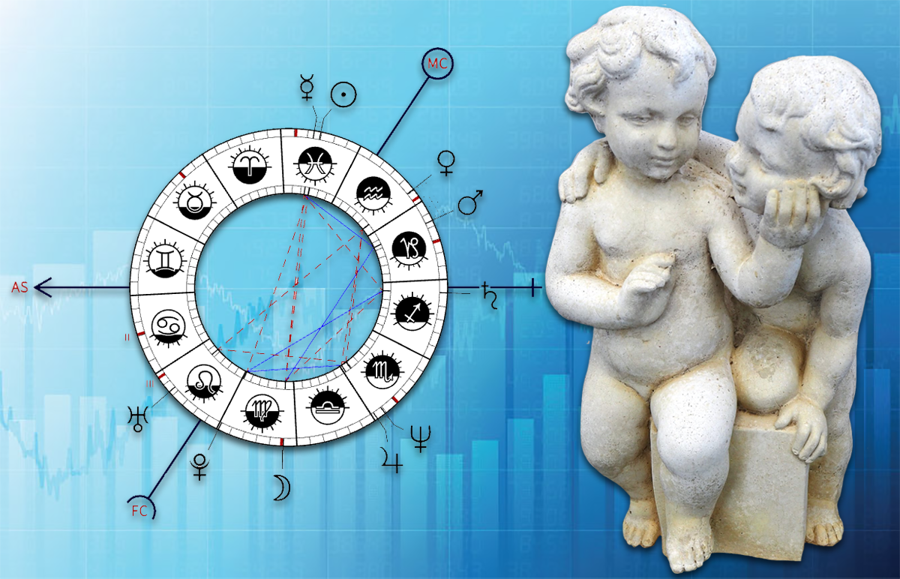
This study was conducted in 2003 by Geoffrey Dean and his sidekick Ivan Kelly. On an unprecedented scale, it was based on 5,591 births, recorded by the National Child Development Study (NCDS) and having occurred between 3rd and 9th March 1958 in the Greater London conurbation, the choice of this restricted space making it possible to minimize the theoretical impact of the effects of longitude and latitude. About 92% of natal times were accurate to within 5 minutes. From these data were extracted 2100 pairs of astral twins, of which 73% were born within 5 minutes before or after and 4% within 15 minutes.

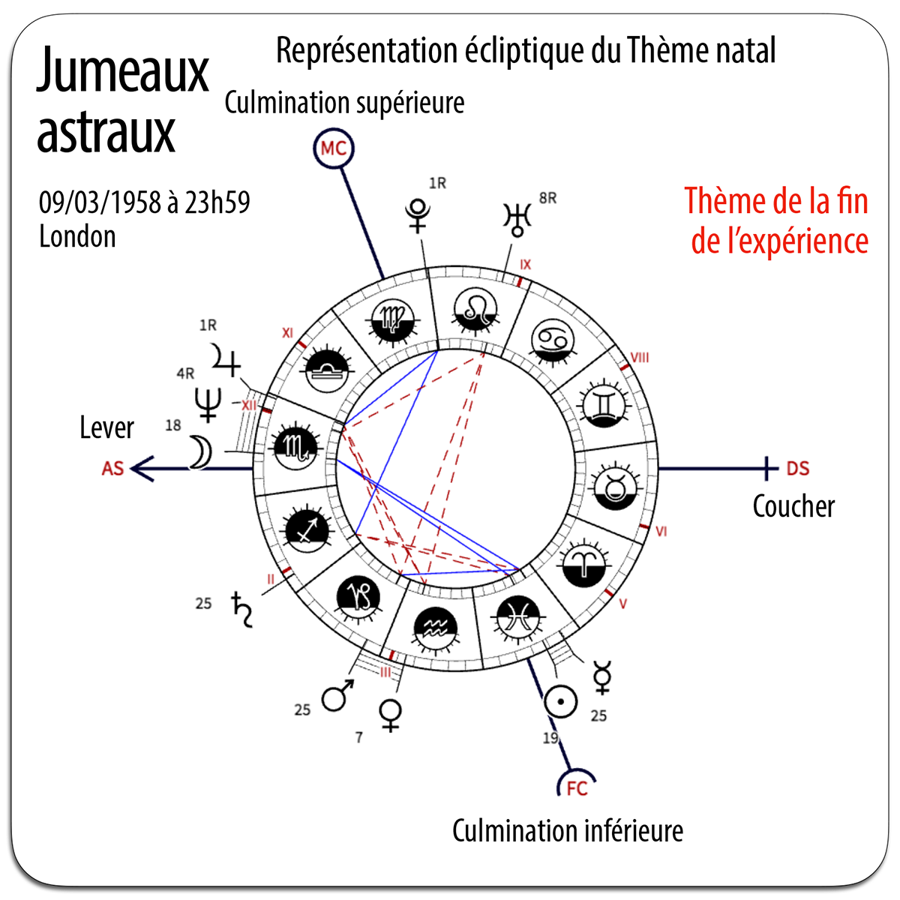
To carry out this statistical study, Geoffrey Dean based himself on a population sample other than that of Gauquelin statistics: that of “temporal twins”. Also called “astral twins”, these are individuals born in sufficiently close temporal and geographical intervals for them to have identical or similar natal charts. According to Dean, “at any given moment, the natal chart supposedly indicates an X line, the next moment a Y line, and so on. So temporal twins should be more like X than expected by chance, which makes them THE definitive test of astrology, since all confusing reading artifacts are avoided.” We are going to demonstrate that this peremptory assertion is meaningless.
The test looked at the correlation between the astronomical fact of Saturn setting and various features (which Dean calls “features”) assigned by “traditional” astrology to Saturn, and more precisely to a square Aspect (angular difference in ecliptic longitude of ±90°) Saturn-Moon. To verify whether or not this correlation was confirmed by statistics, the results obtained were compared with those given by various variables and in particular with those of a psychometric test on cognitive abilities and another claiming to measure “the extroversion”. And what logically had to happen happened: this statistical study invalidated the irrationally hyper-deterministic assertions of “traditional” astrology. This does not in any way mean that this study has invalidated the astrological effects in themselves, since these are of a conditional nature, i.e. they only operate within a bundle of extra-astrological variables that modulate their expression without changing their nature. But before developing this argument, let’s present this test.
Astral twins are far from rare. In a city of one million, more than 20,000 (2%) have an astral twin born less than a minute apart, and about 200,000 (20%) with an astral twin. difference of less than 10 minutes. There is roughly the same proportion in twins from the same uterus during the same gestation, whether they are monozygotic (about 1/3 of the total) or dizygotic. And these numbers increase very quickly with the size of the city and by accepting time differences greater or much greater than 10 minutes. Geoffrey Dean rightly concludes that “therefore, the number of temporal twins in Western history is so enormous (hundreds of millions), that many similarities in personality and events will occur by chance alone.” One can even reasonably add the hundreds of millions of Eastern History, for good measure and to be fair.
“It results”, Dean continues, “that the handful of cases routinely cited by astrologers cannot hope to be convincing.” And he’s right about astrologers “traditional”, who are mostly hyper-deterministic and believe that “the horoscope is the Subject”. Which means that for them, the personality, the history and the destiny of an individual have as their sole cause the state of the sky at the time of his birth. This is of course an easily demonstrable absurdity, even without the support of statistics covering hundreds of thousands of cases. A little observation is enough. But plenty of observations over several millennia also show that Dean isn’t quite right.
Because after all, if the astrologers managed to assign to the Signs & planets certain “influences” characteristics on human behaviors, it is for a specific reason. It is indeed by observing resemblances, not between the astral twins strictly speaking, but between multitudes of individuals born under different skies and at different times, but with certain identical or similar zodiaco-planetary configurations or positions, that they have painstakingly and patiently achieved these results. And these results are nothing but the productions of primitive statistics. It is not necessary to be perfect astral twins to have “character traits” similar, and authentic uterine twins can have “character traits” Very dissimilar. The reality of observable similarities and dissimilarities is much more complex than Geoffrey Dean pretends, and with him all the fatalistic anti-astrologists and pro-astrologists.
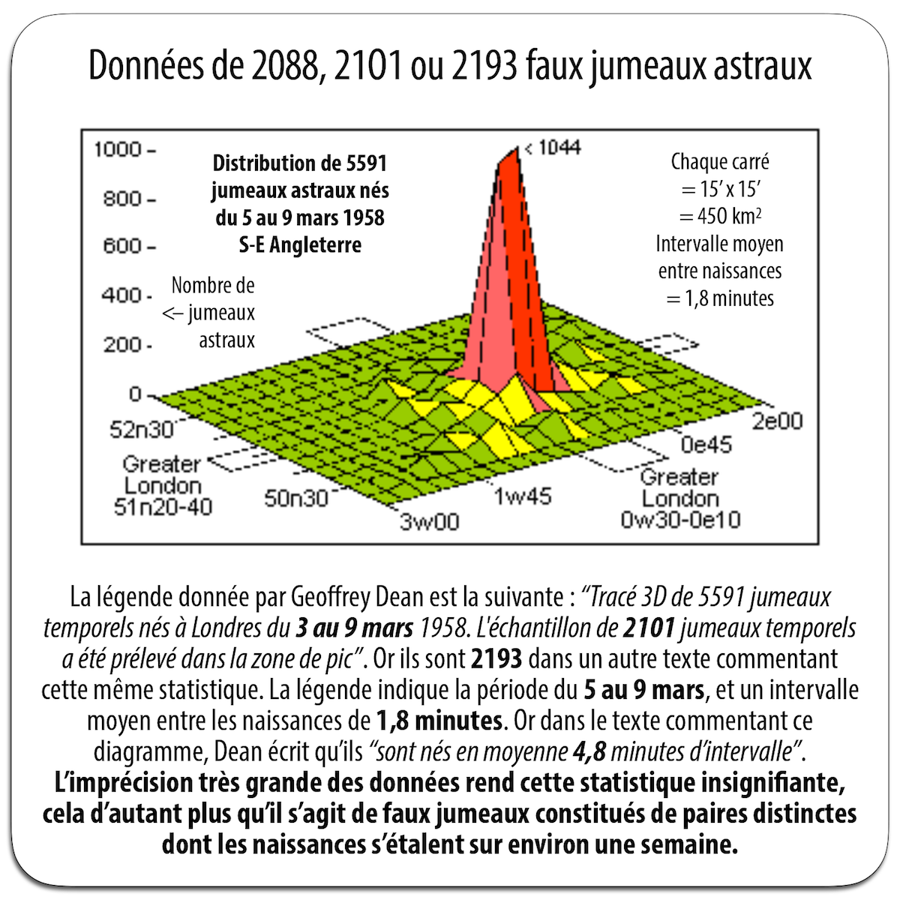
For each person, 110 variables measured at ages 11, 16 and 22 were selected. These variables were both astrological and extra-astrological. The precise list of the 94 variables that Dean and Kelly considered specifically astrological was submitted to 7 “eminent” astrologers who unanimously approved it: for the latter, it therefore summarized the elements which were all supposed to be shown by the native sky chart. Among the 16 extra-astrological variables were, for example, the age of the mother, her blood pressure and at the time of delivery and the duration of the delivery. “Eminent” astrologers all agreed to consider that these 16 variables could not come under the native sky chart.
The measurement of the 94 variables considered specifically astrological included test scores for IQ, reading, and arithmetic; behavioral evaluations about “the anxiety”, of “aggressiveness” and some “sociability” from teachers and parents; physical data such as height, weight, vision and hearing; self-assessments of abilities, for example in art, music or sports; and a variety of others such as occupation, accident proneness, and marital status. Dean also specifically mentions a measure of extroversion scores made on a tiny sample of 103 cases (or about 20%) which he says is based on “a combination of ratings on 13 relevant scales, such as impulsive, cautious, and sociable traits”, which is very imprecise to say the least. The use of the term “extroversion” and the very frequent references to Eysenck psychometric questionnaire EPQ in Dean’s writings suggest that these extraversion diagnoses are actually EPQ test results, but Dean says nothing about it. Which is a considerable fault when one plays the precision-obsessed anti-astrologer lesson giver.
At this stage we can already establish an unanswerable statistic, whose highly significant results are indisputable: there was 100% “eminent” astrologers renowned enough and yet fools, ignoramuses and fatalists to consider that all of the 94 variables listed above were contained in a natal chart of the sky. But let’s not throw stones at these 7 imbeciles and at them alone: they constitute an entirely representative sample of what the majority of astrologers believe and think “traditional”, and it is not necessary to carry out a statistical study to know and see it. But then a first conclusion is in order: what Geoffrey Dean’s study of astral twins measured, among other things, is not any astrological effect, but the proven fatalistic stupidity of 7 “eminent” astrologers. Nothing less, nothing more. This simple fact already considerably relativizes its scope.

Most of the 94 variables considered specifically astrological by these 7 “eminences” are indeed not at all. IQ scores depend on both genetic, environmental and socio-cultural factors, and not at all astrological. A fool can be born on the same day, at the same time and in the same place as an intellectual genius. Reading and arithmetic scores depend in small part on IQ and in large part on education and social factors that it is futile to look for in the natal horoscope. Just as it is absurd to look there for height, weight, visual or auditory faculties that result from genetic, health and environmental variables. Aptitudes for art, music or sports are above all socio-cultural factors (for the first two) and innate and/or acquired physical factors (for the second). With the same Natal Chart one can develop artistic, intellectual, or sporting qualities, and even two of these or all three at the same time.
The profession that one exercises is not indicated in the stars at birth, it is part of socio-cultural determinisms and opportunities related or not to IQ. There “accident proneness” is such a vague variable that it is insignificant: what accidents are we talking about? Are systematic violations of the highway code inscribed in the native sky or in a faulty education leading to incivility and/or recklessness? The same is true for marital status. In the not-so-old days when marriage for all was the norm, almost everyone was married. In Western societies, cohabitation and even celibacy have now become accepted norms. Marital status is therefore a sociological variable, not an astrological one.
Behavioral patterns also cannot be reduced to what a native star chart can say and even predict. To keep only the examples retained by Dean, one can be or become anxious, aggressive or sociable for extra-astrological reasons and unreasons of various natures already listed. A Natal chart only offers a canvas of tendencies which will be actualized in different ways according to the extra-astrological context in which it will be brought to develop in interaction with other social, cultural, geographical, historical conditions, etc. There is no psychologist fatality.
The joint and unanimous incompetence of Dean and the 7 “eminent” astrologers was not having been able to distinguish the terrestrial heritage from the celestial baggage, the extra-astrological variables from those which are not. But it must be recognized that these false enemies were unanimously in agreement on one point: this study had no objective purpose other than to test the assertions of fatalistic astrology. In this he was very conclusive, to the great satisfaction of Geoffrey Dean and to the great despair of the 7 imbeciles and all the fatalistic astrologers they represented.

Let us return to the analysis of the study in question. It is divided into two distinct parts. The first part involves 5591 people born between 3rd & 9th March 1958. From this sample were extracted 2100 astral twins. But the graph by Geoffrey Dean illustrating this selection indicates that the size of this sample is 2088 and that the period concerned is from 5th to 9th March. 12 twins and 2 days have therefore evaporated between the image and the text. Dean does not specify the duration of these births. By dividing 2100 (or 2088) by 7, we obtain 300 (or 298) astral twins per day if we divide the same numbers by 5, the number of twins per day is 420 (or 417). These repeated inaccuracies (they are found identically in 2 different texts published at 13 years apart, which leaves plenty of time to make the necessary corrections) are highly suspect and these data are therefore subject to caution.
The sample of 2100 astral twins seems to be of a large size and the timing accuracy impressive, but let’s assume that these births are spread over an entire week. During this time, and by cutting each day into 10-minute slices (minimum useful time to significantly modify the orientation of the sky), we obtain 144 different sky charts per 24 hours, i.e. a total of 1008 (144 × 7). If we take these astronomical realities into account and divide the cohort of 2100 astral twins by 7 or 5, the actual sample of identical astral twins is therefore considerably reduced: it is actually made up of 7 or 5 small cohorts of around 300 or 420 twins per day, each of these cohorts having a different natal sky. This does not prevent Geoffrey Dean from asserting, against all evidence, that “Here, the serial correlation is a direct measure of effect size and is extremely sensitive due to the large sample size”, as if the sample of 2100 were not made up of 5 or 7 groups with different astronomical characteristics, which makes the effect size considerably less significant than he claims.
Nowhere does Dean mention this undeniable fact. Nor does it mention the number of uterine twins (probably ±42 in number), and among these the proportion of monozygotes (probably ±14 in number), whereas an elementary methodological precaution should have encourage comparison of the results obtained by these different groups. This is all the more so since monozygotes tend to resemble each other more than dizygotes. The numbers skillfully presented by Dean thus appear for what they are: a trompe-l’œil, an anti-astrologer fiction. Geoffrey Dean is definitely a specialist in the art of window dressing by skilfully juggling numbers and data.
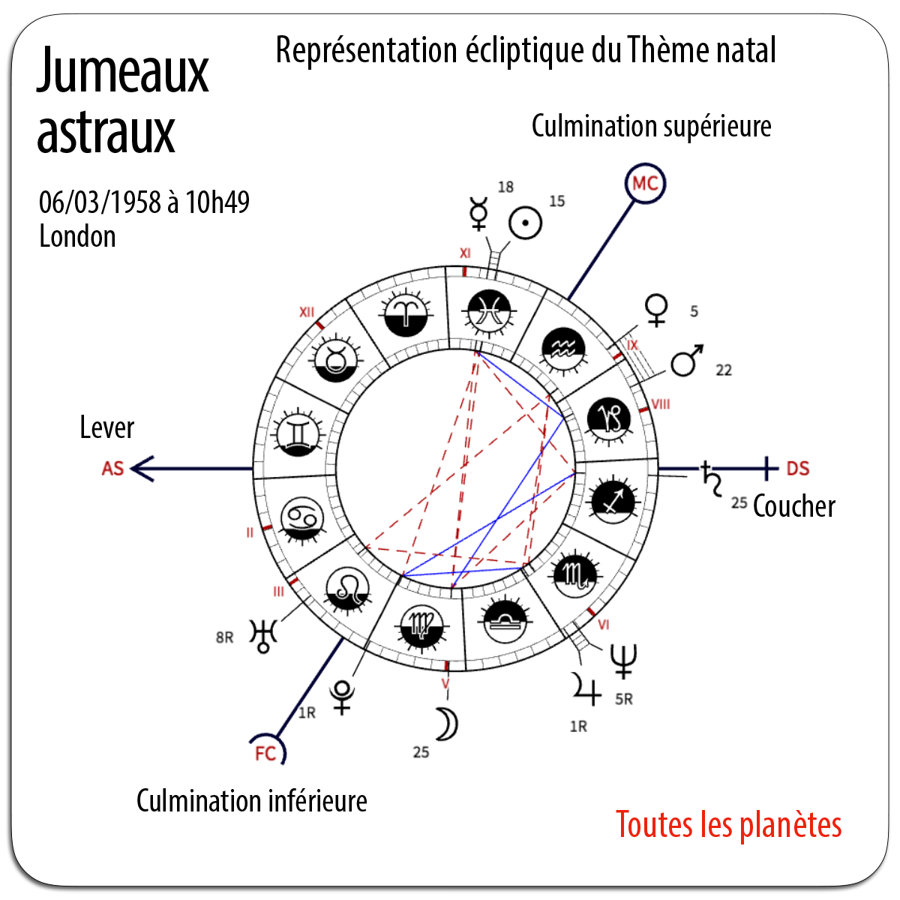
The second part focuses on the day of 6th March 1958 and the precise time of 10:32. It is indeed on this day and at this hour (according to him) that an almost exact square (0° 11′ of orb) between Saturn “exactly opposite to the Ascendant” and the Moon, which Dean describes as “the strongest Saturn event during the entire period from 3rd to 9th March”. Geoffrey Dean does not explain why he decided to focus on this Saturn-Moon square. But after all, it is his right to choose to test a single element. On the other hand, it is a deception on the statistical commodity to claim that this study exclusively intended to test the reality of the effects of Saturn, when it is explicitly the Saturn-Moon duo that it is. We will come back to this later.
Let us first specify that for the geographical coordinates of the London Borough of Wandsworth (50° 30′ N, 0° 10′ W), this saturnian event did not occur at 10:32 but at 10:49. It is indeed at this precise time that the exact setting of Saturn took place and its almost exact square to the Moon (0° 05′ of orb). The cause of this 17 minute error most likely lies in failure to take ecliptic latitudes into account of Saturn and the Moon, which were then respectively +1° 22′ and –3° 06′. However, because of this ecliptic latitude differential, it was impossible to observe both the exact setting of Saturn and the exact Saturn-Moon square. This clarification does not change the substance of the case, but it is an opportunity to emphasize once again the lack of accuracy of the data to which Dean refers. And although this inaccuracy does not alter the results of this test, we will use the time of 10:49 here.
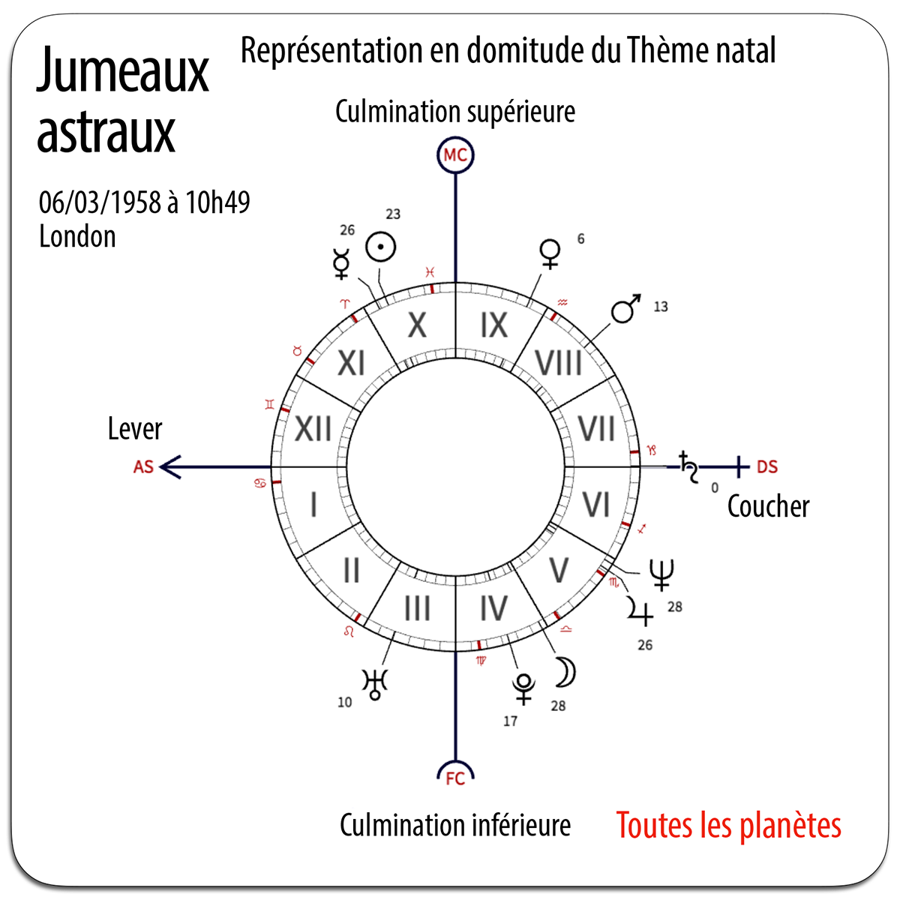
The imprecision of the reference time of this test does not prevent Geoffrey Dean from basing it on two astronomically real but astrologically chimerical facts. He seems indeed to have considered that it was absolutely necessary for him to refer to the exact moment of setting of Saturn and of the Saturn-Moon Aspect. However, having been an astrologer himself, he could not ignore that astrologers admit an orb before and after the exact Aspect, which means that an Aspect does not need to be exact to be efficient. All are very far from agreeing on the maximum extent of this orb but their seven representatives “eminent” which served as a guarantee for this study would most likely have been unanimous in considering that an orb of 5°, even 7° before and after the exact Aspect was acceptable. It is therefore on these objective and measurable data that Dean should have based his study, and not on the only two ultra-precise events that he selected arbitrarily (and which are moreover imprecise as we have shown).
To be even more rigorous and thus better support his demonstration, he should even have statistically tested the results obtained with different orbs. Given the simplistic nature of his general hypothesis and the lack of relevance of the choice of astrological variables on which it is based, there is no doubt that this study would have shown the lack of significance of the orb criterion. The fact remains that Dean is wrong and deceiving the world by asserting that the exact setting of Saturn at the exact square of the Moon is “the strongest Saturn event during the entire period from 3rd to 9th March”. He further asserts that a Saturn-Moon square is “a position traditionally held to significantly strengthen” the strength of Saturn, which is false: an Aspect does not reinforce anything in itself, it only creates a specific relationship between two planets. We will come back to this later.
If we keep the criterion of the exact passages of Saturn at the four angles of the local sphere but we arbitrarily admit a very reduced orb of ±5°, it actually occurs 13 “saturnian events” major during this period. They don’t just concern the Moon on 6th March, but also Mercury from 7th to 9th March. And if we accept as a majority of astrologers a larger orb of ±8°, the Saturn-Mercury square can then be considered efficient from 6th March, therefore at the same time as the Saturn-Moon square. And what Geoffrey Dean should have tested on this date is a double square from Moon and Mercury to Saturn. And even in this case, it is very likely that the results of this truly fit-for-purpose statistic would have invalidated the astrological assertions for the reasons already mentioned.
The table below summarizes the real 13 “saturnian events” for the period concerned if one arbitrarily admits an orb of the Aspects of ±5°. The red boxes indicate the events that astrology deems the most important, that is to say the times when the planets in Aspect are at the same time angular at the AS, at the MC, at the DS and at the IC, which occurs 7 times. The black box designates “the strongest Saturn event during the entire period from 3rd to 9th March” according to Dean. He’s not one of the 7 “saturnian events” major of this period and owes its privileged status only to a chimerical precision which does not measure the same thing as what astrologers measure. But it is true that the quest for absolutely precise measurements often leads to out of measure, as the mathematician, epistemologist and writer Denis Guedj has very well demonstrated in his excellent book The meter of the world.
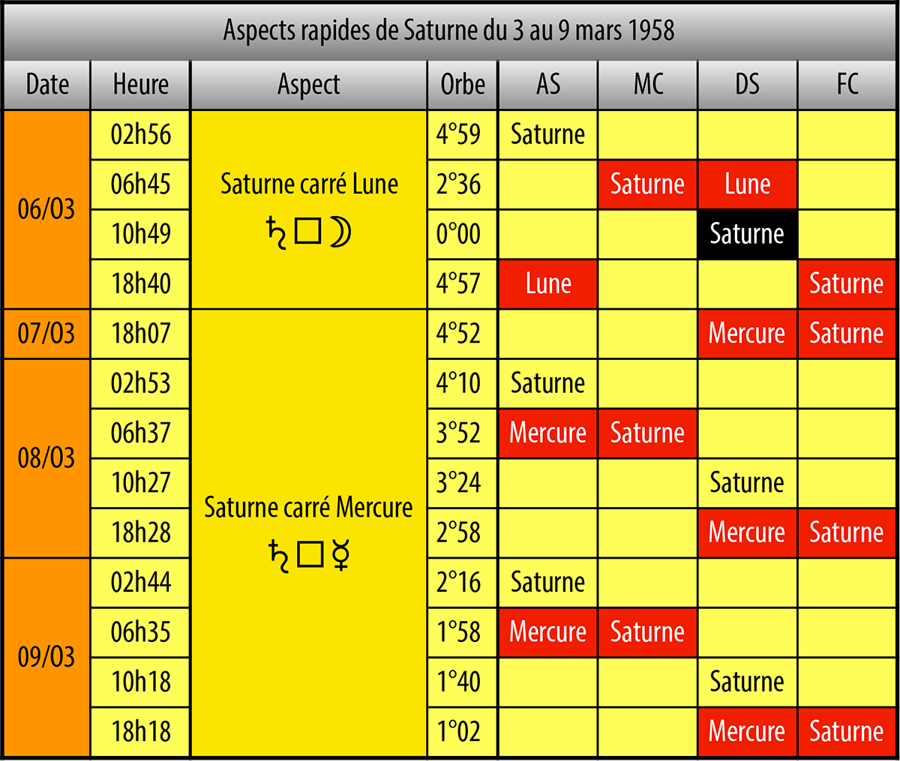
Let us return to the analysis of the results of the second part of this study. The object of this one, remember, was to test a sample of astral twins born on 6th March at 10:49, of which 73% were born at ±5 minutes and 4% at ±15 minutes from this time. fateful, and to verify whether or not they had common characteristics corresponding to the astrological assertions relating to a Saturn-Moon square considered to be dominant.
Of these assertions, Geoffrey Dean seems to retain only two key words, since to describe them he is content to mention that “Saturn is considered to indicate restriction and limitation.” These are indeed words that are found very frequently in the saturnian lexicography of traditional astrology. But there are many others that also have high frequencies, such as “concentration”, “method”, “patience”, “deep thinking”, “distance”, “stability”. And these words are not at all of the same register as “restriction” and “limitation”. We can even affirm that they do not belong to the same lexical field.
The words “restriction” and “limitation” do not provide any useful information on the psychological functioning of an individual, unless taken at face value. In this case, they take on an almost pathological and in any case systematically derogatory meaning: to say vaguely of someone that he is “restricted” and “limit” is never a compliment. The words “restriction” and “limitation” only make sense if we specify what is the object of “restriction” and “limitation”. To illustrate this, let us take the example of two individuals, one preferring his outer life and the other his inner life. These two attitudes are in principle opposed, and yet they are organized around restrictions and limitations. The being of exteriority restricts and limits the field of its interior life and, conversely, the being of interiority restricts and limits the field of its exterior life. It is easy to see that describing these two individuals so different as identical, because followers of the “restriction” and some “limitation”, has no meaning in itself and does not make it possible to realistically assess their respective behaviors.
Reducing the astrological characteristics of Saturn to the “restriction” and to the “limitation” is therefore meaningless and insignificant. Yet it is on these criteria alone that Geoffrey Dean first based himself to statistically evaluate the “saturnity” of his sample of astral twins. To do this he allegedly gave 2,193 of them a mixture of fifteen cognitive tests covering data such as intelligence, reading and mathematics, and compared the results obtained with the supposed saturnian propensity to “restriction” and to the “limitation”. It is obvious that the statistical result obtained did not make it possible to observe a clear dominance of idiots, illiterates and zero in math because of “restriction” mental or of “limitation” intellectual. This is all the more so since a natal chart gives no information about such cognitive abilities, which are extra-astrological variables. Dean concluded that there was no saturnian effect, which is an intellectual scam. Once again, we swim with Geoffrey Dean in full quackery in an ocean of crap.
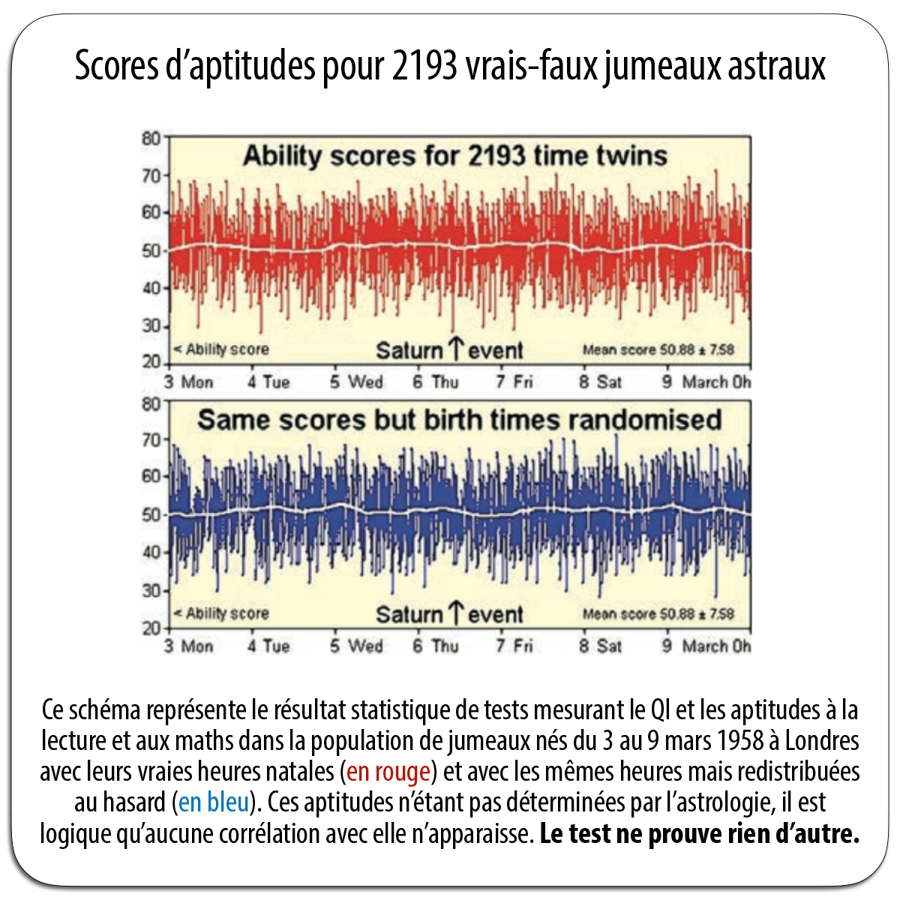
The diagram above accompanied Dean’s study. It shows very well that the 2100 astral twins (mysteriously become 2193) were spread over the whole week from 3 to 9. The study therefore concerned ±300 twins per day (or ±313 if we retain the figure of 2193), i.e. 7 distinct samples, each of them located within the total of 1008 theoretical sky maps already mentioned above. We are therefore now certain that the samples of identical astral twins are extremely small in size. If we consider, for example, that these births were evenly distributed in each 10-minute slice corresponding to 144 daily theoretical sky charts, we only obtain the figure of ±2 twins every 10 minutes. This egalitarian distribution is very unlikely and Dean does not give the details. But whatever it is, the number of identical astral twins per day and per 10-minute time slot is very low. It can be evaluated on average at ±50 if we conjecture that they have, for example, concentrated on 6 time slots per day. Drawing conclusions from statistics on such small samples is simply not serious. This is the reason why Geoffrey Dean prefers to brandish the anti-astrologer propaganda figure of 2100 (or 2193) which fraudulently groups together all the so-called twins, whether or not they have the same star charts.
Would Dean have secretly acknowledged (but this is only a very uncertain conjecture) that the words “restriction” and “limitation”’ were perhaps not the most relevant, especially alongside a composite aptitude test for intelligence, reading and math? Very probably not, but he nevertheless affects to doubt it to introduce the second part of his statistical device, devoted this time to the psychological evaluation of the twin sample: “But can we be sure that the test is really appropriate? It may be that aptitude is too broad a measure to show the effects of Saturn, in which case we need something like extraversion which is more clearly related to Saturn (cautious, reserved).”
“Extroversion”: so here is Dean pricked himself with psychologism and he does it by brandishing the banner of a single word. He first asserts that with a saturnian dominance, “Astrology predicts a drop in extraversion scores.” And to prove astrology all wrong, he referred to a psychological test based on “ratings on thirteen relevant scales such as impulsive–cautious and liking parties” applied to 103 twins born on 6th March. This very small sample was born in a time range between 3 hours before and 3 hours after the fateful hour of 10:49. If we divide this duration of 6 hours into parts of 10 minutes, there are therefore 36 groups each having a slightly or very different natal chart, each group being composed on average of less than 3 twins. The graphic accompanying Dean’s text also specifies that only 12 births had taken place in a 12-minute period around 10:49. Such samples are far too small to draw any conclusion whatsoever. And especially if the statistic is based on the standard of a psychological test that does not specifically concern Saturn. What we will now demonstrate.
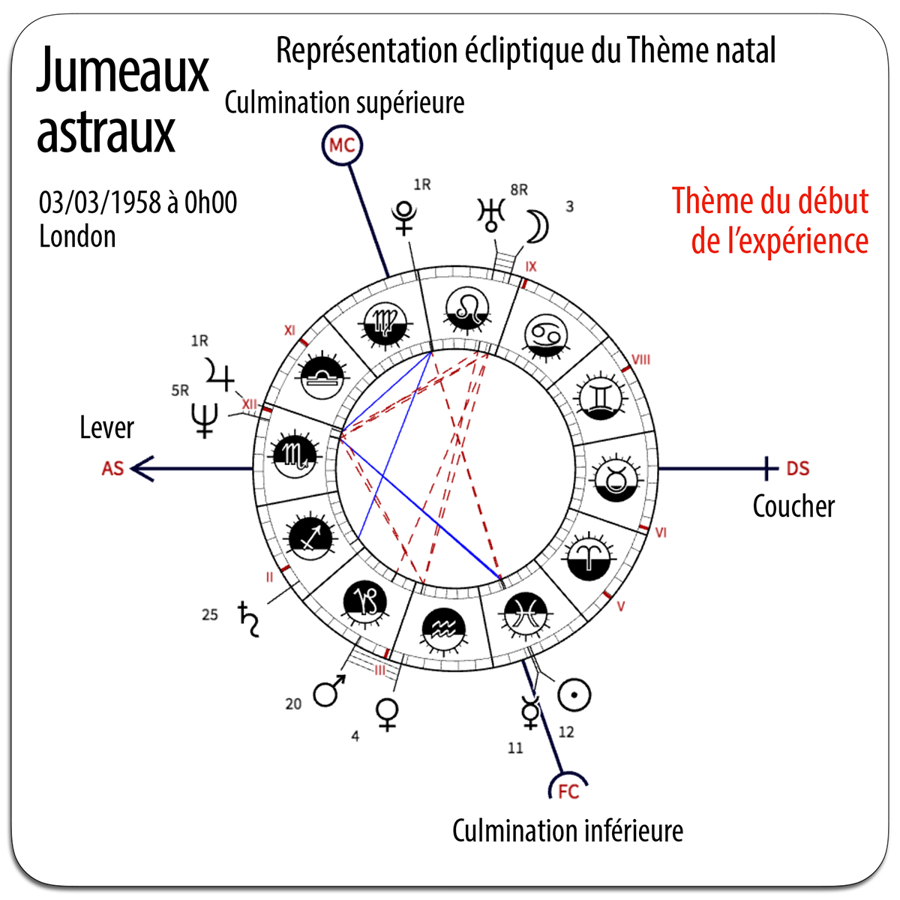
Basic cognitive assessment tests do not pose major validity problems when they relate to data such as intelligence, reading and mathematics. However, they must have been carried out by a competent psychologist who has taken care to pass these tests in optimal conditions for the person. We can of course disagreeing with the definition of intelligence as measured by IQ, but this measure is objective, as are reading or mathematical problem-solving skills and the speed with which these operations are carried out. It is objective because this type of test excludes in the individual who is subjected to it any possibility of subjective biases such as those of ignorance, acquiescence, central tendency or social desirability. The only possible subjective bias consists in the decision that an individual can make to give voluntarily erroneous answers and to be very slow. He then exposes himself in the most extreme case to being considered as unintelligent, illiterate and incapable of abstract reasoning. It is generally not in its interest, except in exceptional cases. It is not the same, and by far, with regard to psychological evaluation tests.
It is customary to differentiate between sciences “hard” and science “soft”. The former, such as mathematics, biology or physics, are exact sciences. From theorems, justifications, and mathematical approaches, we arrive at a result that is either true or false. There is only one alternative, no middle ground. Similarly, biology and physics study indisputable phenomena from which they derive precise laws which present themselves as indisputable until new discoveries call them into question. Sciences “soft”, also called “social science” or “social Sciences” such as economics, sociology or psychology, are sciences of inaccuracy. What they measure or claim to measure is a moving and variable reality to which they try to adapt and which they strive to theorize. The particular phenomena that they extract from it, very often arbitrarily, are debatable and almost systematically disputed. The “soft sciences” are therefore a field where vagueness, imprecision and contestation reign, so much so that the most hard and fanatical of scientists go so far as to harshly and fanatically contest the status of “science” assigned to them.
We will not follow them in this field, but it is clear that in the field of science “soft”, psychology occupies a place of choice. We are not going to make an inventory here of the many contradictory or antagonistic psychologist theories, based or not on facts, which claim to explain or shed light on the laws of the functioning of behavior, character and human personality. Suffice it to say that these approaches can be classified into two distinct groups: the “type theories” and the “line theories”. The first insist on the exclusively qualitative nature of individual differences, considered as innate and reduced to “kinds” simple, compound or complex, and are generally based on an explicit theory which bases them a priori. The second results on the contrary from a quantitative and empirical approach consisting in the observation of “features” they also simple, compound or complex, take more into account the acquired characteristics of these, and aim at a pragmatic classification of the differences.
Very different, the “type theories” and the “line theories” however have at least one point in common which particularly interests us here: their reference to extraversion and introversion, two concepts forged by the psychologist Carl Gustav Jung. With a view to “typical” of this, they are two fundamentally distinct categories, one of which is the association with others “kinds” also Jungians such as the Sensation, the Feeling, the Thought and the Intuition would cover and theoretically explain all the phenomena relating to individual psychology. The “line theories” have taken over this opposition “typical” between extraversion and introversion, but making them the two poles of a single continuity on which most individuals distribute themselves. From the perspective of “type theories” so, we are or are not extroverted or introverted. And from the point of view of “line theories”, one can be a little, a lot, passionately or not at all extroverted or introverted.
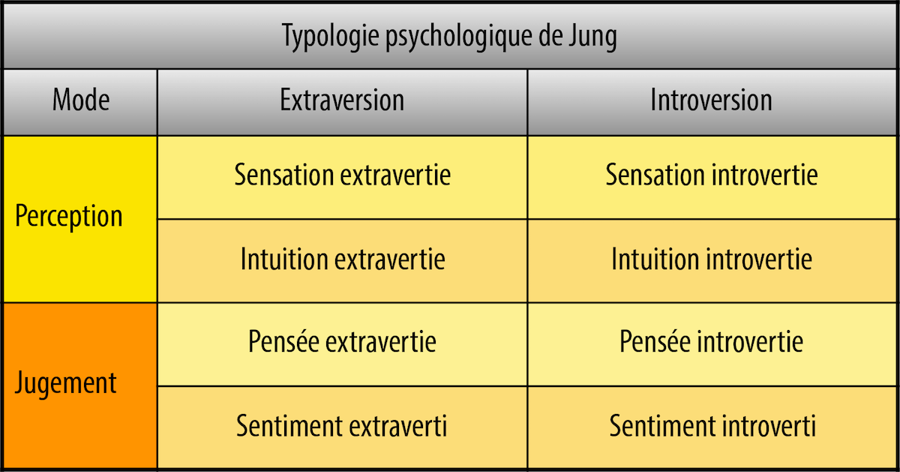
For a very long time, psychologists as such were devoid of existence, and those who then more or less acted as psychologists then for the most part referred to the ancient theory of four temperaments Choleric, Sanguine, Phlegmatic and Phlegmatic developed by Hippocrates about 2500 years ago. They did not bother to measure them and were content to evaluate them with a guess, with a wet finger or very rarely through astrology.
With the first stammerings of the scientific psychology around 1875, that started to change. But it was not until the turn of the 1940s that psychologists began to use psychometrics to try to empirically, experimentally and statistically measure the psychological dimensions and structures of personality, in particular using questionnaires. However, we can only measure variables (or more precisely their values), given that the measurement of an invariable phenomenon is in itself insignificant. The problem that then arises is that of the abstract, non-directly observable character of psychological variables. No direct measurement of a “type” or a “trait” not being possible, it is first essential to define these very precisely, then to “operationalize”, i.e. to match a supposedly objective reality (e.g. the answers to a test) with a psychological dimension — a “type” or one “trait” given. It is only at the end of this process that it is possible to access what can come closest to a relative commensurability. Another problem then arises: that of the objective validity of the tests.
The tests come in the form of questionnaires (necessarily oriented) to which the individual is supposed to respond objectively, rationally, sincerely and knowingly, that is to say of himself (or of another, if the test concerns his own evaluation of the psychological characteristics of others). This is of course a pure ideation. In reality, no test can avoid a high degree of subjectivity… which other tests are supposed to correct and reduce. The four main subjective biases are ignorance bias (very common fact of having poor or non-knowledge of oneself), the acquiescence bias (frequent tendency for some to answer “Yes” rather than “no”, regardless of the question asked), the central tendency bias (widespread tendency to use only the proposals at the center of the response scale so as not to give a clear-cut opinion out of indecision or ignorance), and finally the social desirability bias (tendency of some respondents to give answers that they think will give a good impression of themselves).
The social desirability bias is specific. Present in the written answers, it can take on a disproportionate extent in the context of a questionnaire associated with a face-to-face interview, during which the tested person wants to please (or displease) the tester, or even in that of a professional recruitment (psychological testing is also a very lucrative business). Finally, we must not neglect the importance of biases & cultural variables, which pose the problem of the universality of the most widespread models. These are Americans, so from a culture that overvalues extroversion, whereas, for example, Japanese culture favors introversion more.
These many and various biases affecting the validity of personality tests do not seem to have had a large effect size in the mind of Geoffrey Dean when he used one of them as a standard for measuring saturnity. hypothetical London astral twins. However, given the tiny sample size (103 individuals divided into multiple subgroups), subjectivity biases could have had a decisive influence on the results. Dean should have conducted a counter-investigation, but he didn’t since the results suited him.

Psychological tests therefore only indicate probabilities, and the correlations they make it possible to obtain often have little statistical significance. In an attempt to increase this and therefore in the hope of better approaching the fuzzy complexity of reality, but also to supply the trade in tests with marketable novelties, psychometricians are constantly perfecting their questionnaires, regularly adding new items to them, observe or invent new dimensions of personality in the form of “kinds” or of the “features” which themselves break down into multiple subtypes and subtraits, etc. From all this it follows that the results of purely psychological tests, even those which present themselves as the most serious, are not indisputable. It is therefore necessary to be very naive, in bad faith or ill-intentioned to make it an indisputable objective criterion to distinguish what is true and (especially) false in astrological assertions.
This is particularly the case for tests inspired by theories of Hans Jürgen Eysenck. In the category of “line theories”, they are among the tests that obtain the lowest correlation rates. It is moreover in the case of Eysenck of a “type theory” inneist disguised as “trait theory”, given that it only very weakly takes into account the role of the environment in the formation of character traits. Geoffrey Dean having always used the Eysenck tests to support his anti-astrological studies (and perhaps also in the case of the London twins), it is essential to present the conception of the personality on which they are based.
Eysenck proposed in 1947 a first descriptive model of individual psychology. According to this simplistic theory, the dimensions of personality would be reduced to two basic and independent traits: the extroversion (openness, talkativeness, high levels of positive affects such as feeling good, need for external stimuli) and the neuroticism (emotional instability, high levels of negative affects such as depression and anxiety). These two traits are bipolar and define a direction indicating a graduation scale from 0 to 24 between, on the one hand, minimal and maximal extroversion, and on the other, minimal and maximal neuroticism. In this model, introversion and emotional stability are only conceived as the zero values of extraversion (“E”) and neuroticism (“N”). This is therefore a very oriented choice in favor of “E” and “N”.
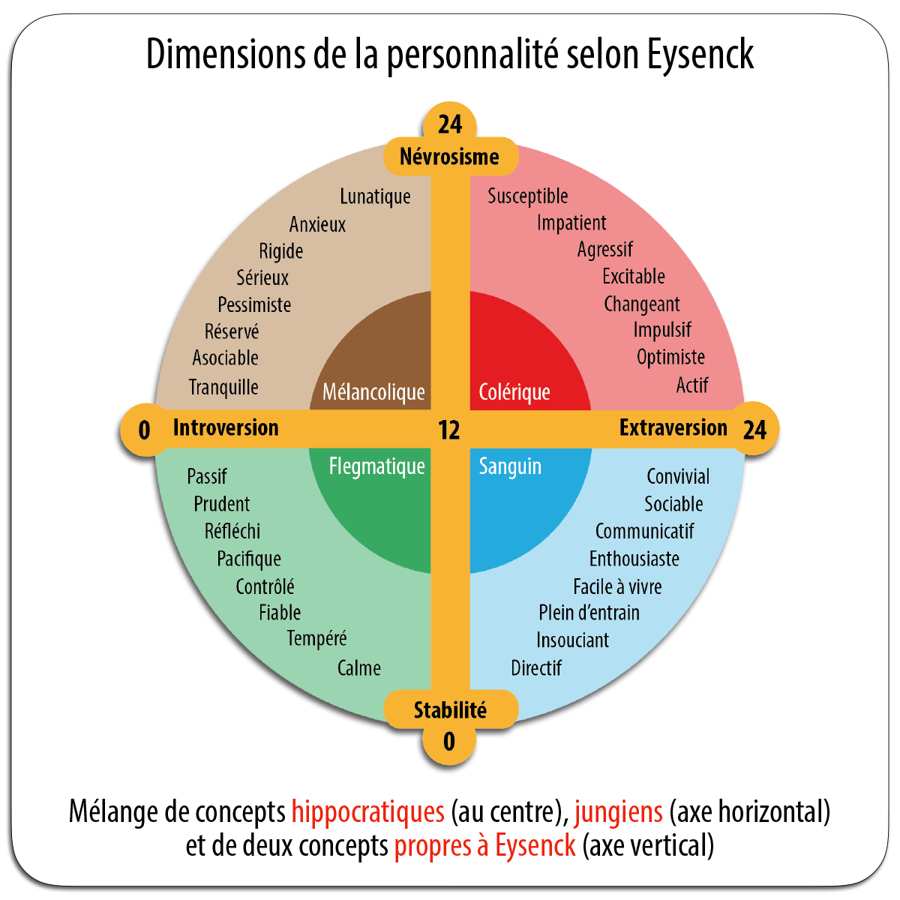
These two perpendicular bipolar axes delimit four quadrants designating as many compound sub-traits: stable and unstable extroverts, stable and unstable introverts. This classification seems new and original. But she is not. On the pseudo-novelty side, the four sub-traits are nothing more than a transposition, in a modernized descriptive vocabulary, of the four Hippocratic temperaments resulting from the theory of the four humors: the stable extrovert is the Sanguine, the unstable extrovert the Bilious (Choleric), the stable introvert Lymphatic (Phlegmatic) and the unstable introvert Atrabiliary (Melancholic). On the pseudo-originality side, the traits of extroversion and introversion are borrowed from Jung for whom it was a question of types more than traits. To tinker with his model, Eysenck therefore only superimposed two simplified Jungian concepts on the four temperaments of Hippocrates. We can thus consider this first theory as a vulgar amalgam.
Note that the 4 Hippocratic temperaments are associated with the 4 Aristotelian Elements (Fire-Choleric, Air-Sanguine, Earth-Melancholic and Water-Phlegmatic), and this theory of the 4 Elements is one of the pillars of so-called “traditional” astrology. It is indeed with this theory that it explains the properties & meanings of the Signs and the planets. The 4 sub-features of the Eysenck model are therefore equivalent to the 4 astrological types. In addition, each Element is broken down into its primary Qualities (Hot, Cold, Dry, Humid): Fire is Hot & Dry, Air Hot & Wet, Earth Cold & Dry, Water Cold & Wet. The 4 Qualities thus constitute two perpendicular bipolar axes (Cold-Hot, Wet-Dry) which are identical to the Introversion-Extroversion and Stability-Instability axes of Eysenck. We can therefore say that Introversion is cold, Extroversion hot, Instability dry and Stability wet. Eysenck definitely did not invent or discover anything. He brought old Moons up to date.
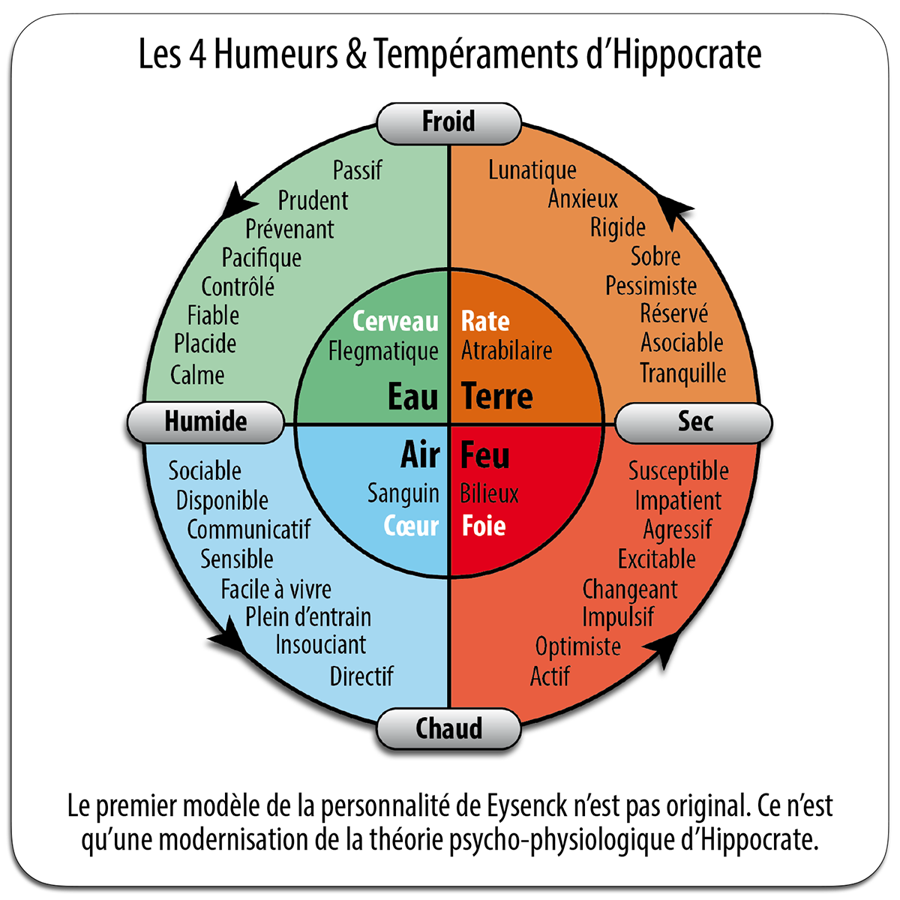
The most paradoxical and amusing thing about this shameless, distorting and misinforming plagiarism is that the tests from this copycat model, from the same sources as that of classical astrology, were used by Eysenck himself and by Dean to invalidate the astrological assertions relating to the Elements attributed to the 12 Signs. This is another matter since we are not dealing here with the zodiac, but with the planets and in particular with the Saturn-Moon duo. Note, however, that Eysenck took a stand in favor of Gauquelin statistics about the planets. Here is what he wrote about it: “I think it’s safe to say that when it comes to objectivity of observation, statistical significance of differences, hypothesis testing, and replicability, there are few data sets in psychology that could compete with these observations […]. I think we have to admit that there is something here that needs an explanation” (magazine New Behaviour, 1975).
The main point here is to point out that the tests from Eysenck’s simplistic model gave weak statistical correlations, and that this fact does not seem to have bothered Dean, since he (probably) made these tests the standard from which to he decided to invalidate the traits attributed to Saturn. And this even though the main criticism he addresses to the Gauquelin studies concerning planetary effects lies in their weak statistical correlations. This amounts to observing that Geoffrey Dean considers that a weak and insignificant signal becomes strong and very significant if it invalidates an astrological assertion, but that the same weak signal becomes non-existent and therefore non-significant if it confirms it.
One might also wonder why Dean only tested the “E” extroversion, and not the “N” neuroticism step of his saturnian twins. He would probably have obtained the same negative results, but at least he would have respected Eysenck’s model. We do not test a hypothesis with a half-standard when the reference standard consists of two elements, it is not serious. Indeed, even if Eysenck considers that “E” and “N” are independent, they are associated in the same model, which means that they are interdependent there. This kind of biased selectivity and ranting demonstrates once again that anti-astrologism is based on pseudo-skeptical and irrational assumptions.
Let’s go back to Eysenck’s model. Noting that the tests resulting from the first version of his theory produced only weak statistical correlations, and that character traits which seemed to him real and important escaped this theory, Eysenck decided in 1974 to add a third factor to it: the psychoticism (“P”) and its shadow, the socialization (“S”). Psychoticism was characterized by coldness, aggression, selfishness, and interpersonal hostility, and socialization by warmth, benevolence, altruism, and friendliness. Eysenck thus went from 2 dimensions to 3 dimensions, the psychoticism-socialization axis “P-S” being perpendicular to the plane containing “E-N”. The EPI tests (initials of Eysenck Personality Inventory) from the first model were then transformed into EPQ tests (Eysenck Personality Questionnaire).
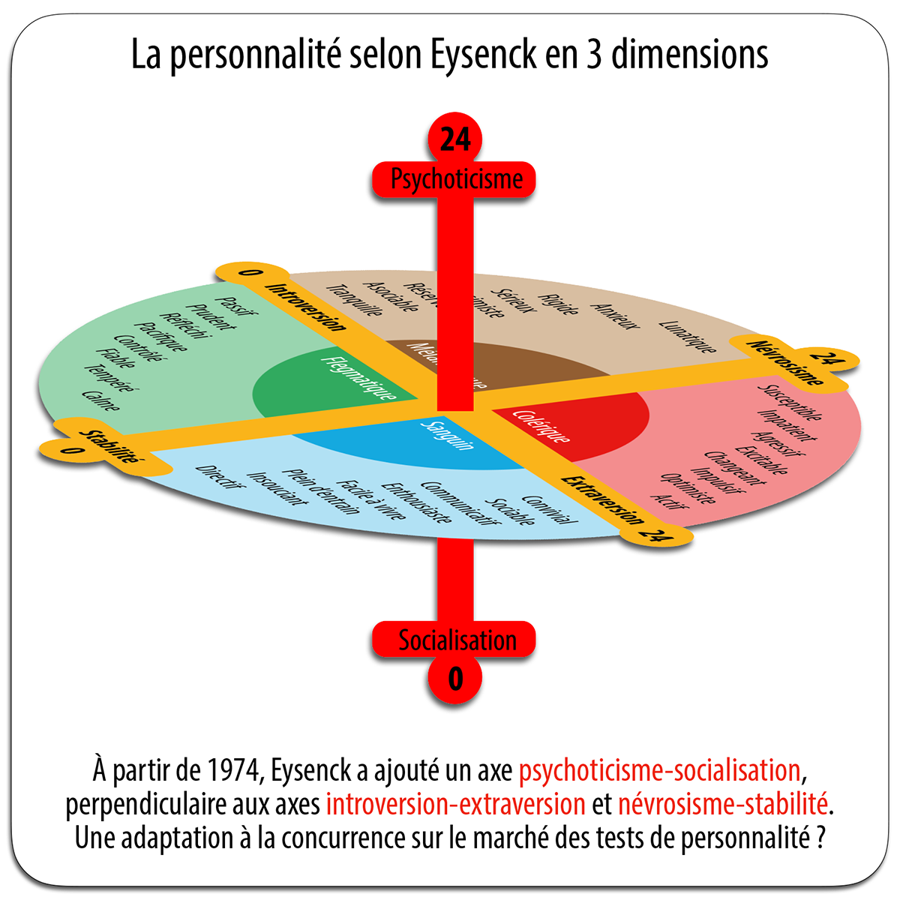
One can wonder about the reason that pushed Eysenck to choose psychoticism as a factor of 3rd dimension. It is not insignificant to note that he did so at a time when the market for psychological assessment tests intended for companies was becoming a very flourishing business in the USA, and that the PPE test was totally incomplete in identifying the profile wanted in senior executives, a combination of aggressiveness and extroversion. And that half of this profile strangely resembled the one corresponding to the highest score on the socialization-psychoticism scale, that of an individual “aggressive, peremptory, egocentric, unsympathetic, manipulative, pushy, dogmatic, masculine, tough”. A set of traits that are so many “qualities” of competitors essential to gain market share against the competition.
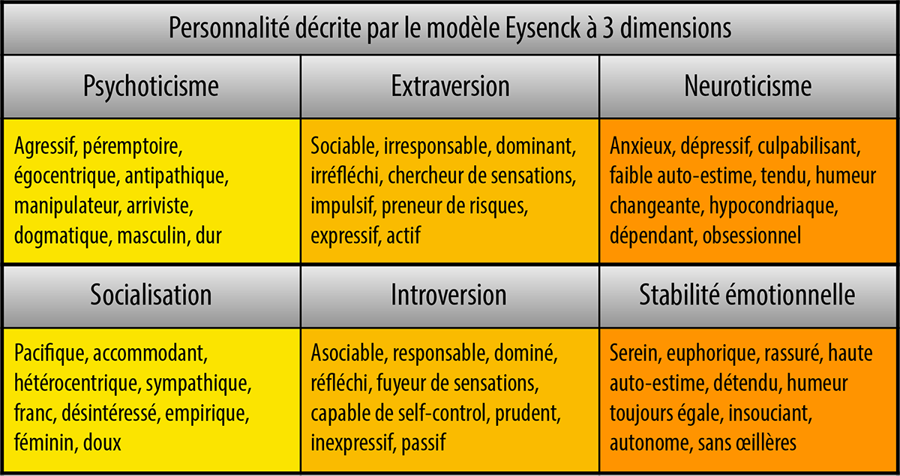
The table above summarizes the qualities and defects of the 6 features of the 3-dimensional Eysenck model. We note that the highest scores that can be obtained in the answers to the EPQ test correspond for 2/3 to forms of psychopathology. This model, which is more psychiatric than psychological, is therefore not very suitable for healthy people. It reveals a clearly derogatory conception of human functioning. It is also sexist, since psychoticism is seen as masculine and socialization as feminine. To understand the reason for this sexism, it is necessary to know that Eysenck associated each of his traits with physiological functions, which has never been proven, and that he thus put exacerbated psychoticism on the account of a very high rate. of testosterone, which has also not been proven. However, this is in adult men about 7 to 8 times higher than in women, which is an indisputable fact. It follows that Geoffrey Dean, if he had been faithful to the evolution of Eysenck’s theory, would not only have had to test the values of “E” and “N” in the saturnian twins, but also that of “P”, differentiating the results obtained by males and females. And of course by testing the testosterone level in females with high “P” scores…
Finally and for the record, Eysenck ended up adding a fourth factor to his theory and therefore a new axis which we do not know if it is perpendicular, orthogonal, oblique or parallel to the first three. This “M-D” axis for Lie-Social desirability was intended to statistically test the ability to pass or fail lies in test answers, and hence in life in general. The test results invalidated that “M” factor, which is kind of funny. A statistical study on very small samples nevertheless claims to have shown that male stockbrokers are statistically both much more psychoticists and more liars than female booksellers. We have fun as we can. For my part, I know a very introverted individual who systematically cheated in his answers to a questionnaire relating to the recruitment of a job profile requiring maximum extroversion. This questionnaire was accompanied by a job interview conducted by a psychologist. This individual was recruited without difficulty. Eysenck’s “M” factor is really a lot of fun. This individual benefited, it must be recognized, from a good knowledge of how tests are made. He could all the better make his answers consistent with his purpose (to be hired). This is not the case for everyone, but it is likely that a significant number of individuals have the same aptitudes, thus introducing into the data, in addition to the biases already listed, one of these “social artifacts” dear to Geoffrey Dean…
Be that as it may, the vast majority of psychologists ended up abandoning Eysenck’s EPQ tests, deemed too unreliable and of too low statistical significance for professional recruitment. Moreover, this innate theory did not take sufficient account of the role of the environment, specific contexts and responses to aptitude tests that could favor the emergence of certain traits that seem essential to recruiters. One should never underestimate the weight of trade of psychological tests in their development. This is not just about science “soft”, but also of salable science and therefore very often sold.

This is how a new model emerged and imposed itself, accompanied by its own string of tests: the Big Five. While Eysenck’s approach was European, theoretical and steeped in old culture, that of the designers of the Big Five was American, empirical and focused on immediate effectiveness. The 5 essential dimensions of personality isolated and described by this model no longer owe much to Hippocrates or Aristotle. The Openness to experience, the conscientiousness, the Extroversion, the Agreeableness and the Neuroticism, only concession to a negative value, are the names of these “big five”. This taxonomy of personality traits is also called FFM (Five-Factor Model).
It has also been baptized with the name of model OCEAN, a transatlantic acronym for these 5 dimensions that resemble a composite portrait of the urban American as he likes to define himself ideally: an empirical pioneer, conscientious, extroverted, friendly and hating to feel vulnerable. Neuroticism (neurotic tendency) appears in this table only as a possibly eliminatory shadow, a figure of what one should not be too much in a capitalist and enterprising world subjected to unbridled competition. Not too much, but a little all the same, since anger and hostility-aggressiveness, which belonged to the field of psychoticism in Eysenck, migrated into that of neuroticism in the Big Five, that personality tests pay little heed to psychiatric nosography. There is thus psychologist literature aimed at recruiters that encourages them not to underestimate the value of a higher than average level of neuroticism among leaders.

Eysenck’s “E-N” model and the model Big Five have only two points in common: their reference to extroversion and neuroticism. The elements of personality that emerge from these two sieves are therefore very different, although the individuals who pass both tests are identical. There is, however, another remarkable similarity: seeing introversion only as the lowest value of extroversion and not as a value in itself.
There is no need to carry out tests, statistical or not, to conclude that extroversion enjoys much better credit than introversion in these models. In this true-false bipolarity in which one of the poles is in fact only the shadow of the other, the extrovert explicitly represents the dominant, therefore the winner in social competition, and the introvert the dominated, therefore the vanquished, the “loser”. Despite all the hypocritical precautions of language “politically correct” with which psychologists surround themselves so as not to seem to endorse these devaluing representations for introverts, the descriptive models of personality that they create or use overwhelmingly speak for them: it is extroversion that is put forward.
One can wonder about the reasons for this flagrant inequality of treatment. Could it be the simple reflection of what is at the base a numerical inequality? This amounts to asking what is the proportion of extroverts and introverts in the general population. It is impossible to test a significant enough proportion of them to know. To assess this phenomenon, we can therefore only rely on statistics relating to populations who have already taken tests, which are worth what they are worth. A study was carried out in 2009 on behalf of the Wall Street Journal by psychologists working in recruitment. It was intended to assess the proportion of extroverts among 4,000 very senior American business executives who had taken a test, most likely a Big Five.
According to this study based solely on extroversion scores, the general population of the USA would be made up of 16% very extrovert individuals and 34% having an above-average extroversion rate. The 50% with a rate lower than this are therefore introverts, for whom it was not considered useful to assess their degree of introversion. Introverts and extroverts would therefore be equal in number, but the sources (data and tests) that made it possible to achieve this strict equality have not been published. We can therefore strongly doubt these figures for all the good reasons that we have already mentioned. This is all the more so since other American studies with unverifiable and unsourced data would report a proportion of approximately 2 extroverts for 1 introvert.
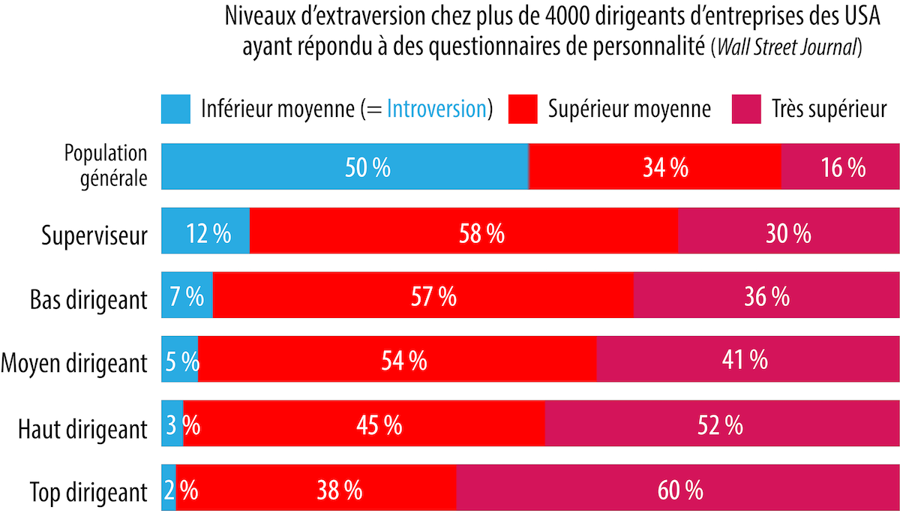
The study carried out for the Wall Street Journal vividly confirmed that introverts were decidedly incurable “losers”. Indeed, the higher one climbed the hierarchical ladder of these very senior leaders, the more the proportion of hyper-extroverts increased, going from 30 to 60%. At the highest level, there were 98% extroverts and 2% introverts. The proportion of introverts who refused to submit to this test out of shame or deep disinterest was not mentioned. No more than the Wall Street Journal did not consider it necessary to give the results concerning the 4 other values of the Big Five. This demonstrates the excessive importance given to extroversion, the collusion of the test business with industrial and financial interests. And which conversely demonstrates the little importance that is given to a real study of introversion in itself, and not as the simple negative stooge of the positive superstar that is extroversion in a world increasingly subject to the triumphant, dynamic and enterprising values of unbridled capitalism. According to another study, also unsourced, about 3 out of 4 Americans would spontaneously prefer to define themselves as extroverts. We understand them, in the land of very extroverted “American dream”.
How can we, in such a context, take at face value the dominant theories of personality (the American ones) and the tests they produce? The answer is categorical: we cannot. The world of university research is far too subservient to that of business. He therefore produces the models that the latter encourages him to produce. Serious research on extraversion and introversion considered as equal values can only be carried out by independent researchers who do not prostitute themselves with the golden calf to obtain their subsidies and funding.
Let’s go back to the test on the saturnian twins. Geoffrey Dean did not specify what type of personality test he used to carry out these “ratings on thirteen relevant scales such as impulsive–cautious and liking parties” in order to determine the degree of extroversion of these 103 astral fraternal twins. If it’s a standard test, it doesn’t mention which one (but it’s probably one of Eysenck’s, although none of them are based on the 13 scales Dean mentioned). It could just as easily be a tinkering based on psychological assessments made by teachers or parents of these twins. However, neither teachers nor parents are trained in psychological assessment. In both cases, it is a serious fault which does not allow the relevance of this test to be assessed. It can therefore be rightly considered a priori as tainted with bias, even insignificant, all the more so since it was only carried out under unknown conditions on a tiny sample.
Let’s admit that this test can have some value. It therefore relates to a correlation, which Dean believes should have been significant, between Saturn and a low extraversion score, a correlation which has not been validated by this test. But what is extroversion?

Extraversion and its symmetrical, introversion, are two fundamental concepts from Jungian psychology that appeared for the first time in 1921 in his book Psychological Types. It is therefore appropriate first of all to refer above all to the meaning given to them by Jung himself before the university and/or commercial producers of the multiples “personality tests” do not seize them by popularizing them to incorporate them into their models. Jung’s precise definitions are as follows: “While the extrovert constantly appeals to what comes to him from the object, the introvert relies primarily on what the sensory impression constellates within the subject.” An extraverted individual therefore draws his information directly from the sensory stimuli of the external world, whereas an introvert only retains from these stimuli those which have left a strong subjective imprint on his internal world. Extroversion in itself therefore has nothing to do with being “impulsive” and of the “love parties”. Impulsivity is a variable that applies to both extroversion and introversion. An impulsive extrovert reacts quickly to the demands of the outside world. An impulsive introvert escapes with the same rapidity. You can be extroverted and not like parties. One can be introverted and love parties that resonate with one’s own sensibilities.
Moreover, extraversion and introversion, in Jung’s view, are not fixed types, nor does he consider introversion to be the mere understatement of extraversion. Extraversion and introversion coexist in each individual, and it is the dominance and constancy of one or the other that determines the “psychological type”: according to Jung, “Every human type has both mechanisms, that of extroversion as well as that of introversion; only the relative predominance of one or the other determines the type.” He also wrote that he “You should know that if each individual has a dominant psychological type, he can pass into the opposite type on the occasion of an emotion, a change of mood, over time and his own evolution.” He even added that “everyone is an exception to the rule” types, and that there was no such thing “something like a pure extrovert or a pure introvert. Such a man’s place would be in an insane asylum.”
Jung’s theory of personality, even if he himself had relativized the too fixed character of his “kinds”, had a big flaw: it had been developed without any control or objective verification, about twenty years before psychology began to become an experimental science. It was only based on the conclusions he had drawn from his own experiences and observations of his patients in the light of his immense culture and beliefs. However, his patients were in no way representative of the general population: they were only people infatuated with psychoanalysis and “depth psychology”, mostly belonging to the upper social classes. Jung’s influence on the field of early experimental psychology was nevertheless enormous through his conception of “kinds”.
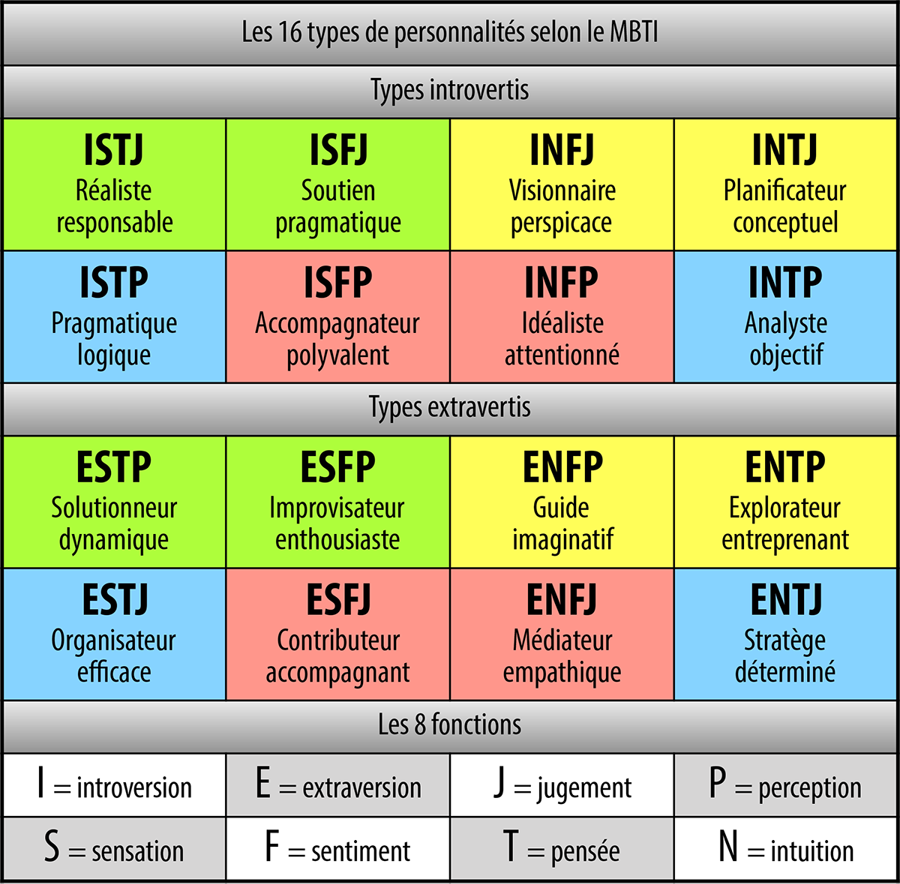
The Jungian psychological types also gave birth around 1942 to a personality questionnaire, the MBTI (Myers-Briggs Type Indicator), based on 16 “kinds” compound Jungians meant to represent so many different personality types. It was designed by Katherine Cook Briggs, and her daughter Isabel Briggs Myers, both of whom had no degree or real knowledge of psychology but great idolatrous reverence for Jung’s work. They made the MBTI a very lucrative business venture, despite the fact that statistical studies made from this model do not show any significant and systematic correlation with the personality of anyone, except by chance. The description of each “type” is indeed extremely idealized, idealized and flattering for the self-esteem of the test subjects, and nowhere is there any mention of character traits that are nevertheless very concrete and very frequent such as selfishness, laziness, meanness, aggressiveness, careerism, greed, etc. In short, the MBTI is only used today by pseudo-Jungian groupies. Forget it: it has no interest.
After experimental verifications, the “kinds” Jungians have disappeared as such and have become “features” and, to stick to our subject, only the notions of extroversion and introversion have been retained, although reformulated in new terms which very significantly modify their qualities. It is these post-Jungian reformulations that matter here, since they are the ones used by most post-Jungian personality models.

Psychometric and statistical studies have shown that most individuals lie on a Gaussian curve between the two extreme poles of extraversion and introversion, which has given rise to a new central group, that of the “ambiverted”, of which there is no trace either in Jung’s work or in later empirical models of personality description. Ambiverts are neither truly extroverted nor truly introverted: their behaviors fluctuate moderately from one attitude to another depending on the situations and events they face. They are even suspected of behaving both extroverted and introverted, i.e. quietly sociable, cautiously adventurous, calmly active, semi-directive, etc. So many ambivalent, paradoxical and subtle character traits that as such escape current models and their questionnaires. They only appear there in the form of high values of introversion or low values of extroversion, which facilitates binary classifications but prevents them from being evaluated as such.
It is therefore not known what the proportion of ambiverts is in the general population. In the absence of a precise and consensual definition of the characteristics of ambiversion, it is true that it is very difficult to identify its statistical reality. And when we know how much the definitions of the limits of extraversion and introversion are the subject of debate and controversy, it is not surprising. To assess the proportion of these statistical phantoms yet made of flesh, bones and personalities, we therefore have to conjecture. The most daring argue that the number of ambiverts (neither extroverts nor introverts or both at the same time) would be around 2/3. In this high hypothesis, there would only be about 1/6 extroverts and 1/6 introverts left “real” if we consider that the two categories are evenly distributed. Others, more selective-restrictive and/or conservative, estimate that real ambiverts constitute only about 1/3 of the population. If that were true, extroverts and introverts “extremes” would each represent only 1/6 of the population.

In either case, we would then be led to conclude that all the answers to the tests relating to extraversion suffer from a very significant initial demographic bias which makes them insignificant in at least 1/3 of the cases, which is huge. If this bias is not corrected using new measures, only the results concerning the high fraction of extraversion and the low fraction of introversion could be considered truly significant.
The personality of a moderately expansive and moderately reserved person, or a moderately expansive moderately reserved person, cannot be seen as a mere juxtaposition of extrovert and introvert traits. The dividing line between the two is at the top of a Gaussian curve where the extremes touch and merge, where it becomes impossible to tell the difference, and therefore where extraversion and introversion become irrelevant criteria for evaluating such personalities. Let us add that we can evaluate at 100% the probability that we do not know the real proportion of ambiverts. Statistics can be made to say anything when they are based on real and verifiable data and on consistent assumptions, and even more so when they are not. This is one more excellent reason to disqualify the crude extroversion test used by Geoffrey Dean to claim to invalidate any correlation between Saturn and introversion in a sample of fraternal astral twins of ridiculous size.
Extraversion and introversion can be expressed very differently depending on the variables with which they are associated. To understand this phenomenon, it is necessary to differentiate temperament and behavior. The temperament is the innate way an individual interacts with and responds to their environment. The behavior is the set of psychological phenomena observable by an external witness. It is therefore made up of both innate characteristics (temperamental) and characteristics acquired during experiences and social interactions.
The timidity is a good example of a behavioral and not a temperamental reflex. We are not born shy, we become. Introversion is often associated with shyness, which is not always true: the natural reserve of the introvert should not be confused with shyness, which is a behavior of fear acquired during interactions with the social environment.: fear of being judged, of being judged by others, of not being up to it, of being rejected, etc. Shyness can thus become a major obstacle to social relations, which is not the case for reserve. We can therefore be reserved but not shy, and the reverse is also true. It’s quite common. However, these two behaviors can be confused by an uninformed observer… or in necessarily subjective responses to tests. These answers are made by individuals who generally do not know the difference between what they consider to be their temperament and their behaviors.
▶ An outgoing and shy individual can give the impression of being simply reserved as long as his shyness is not accompanied by too conspicuous physiological manifestations such as the blushing of his face. He is in fact anything but reserved, and lives in great frustration as soon as he is in a situation of social interaction. His temperament encourages him to seek these, but the fear induced by shyness prevents him from doing so. He can thus find himself most of the time confined to the role of observer in spite of himself. In his answers to personality tests, he will then have a very strong tendency to validate all the positive questions intended to assess introversion, when he is not an introvert, but a shy extrovert.
▶ An introverted and non-shy individual doesn’t have that kind of problem. Its natural reserve can allow it to manage its social interactions very well by filtering them opportunely and at its convenience. He can even show himself perfectly at ease there, given that for him no fear linked to shyness creates obstacles to exchanges and communication. An uninformed observer may be mistaken, and consider that he is dealing with a moderate extrovert. And of course, this non-shy introvert, when he answers the questions of a psychological evaluation test, will have a very strong tendency to validate all the positive questions intended to evaluate his extraversion.
▶ If shyness can take the passive form that has just been mentioned, it can also manifest itself through active behavior. The shy extrovert can thus ward off and compensate for the fear that his shyness causes him by often being aggressive or by showing an excess of insurance in his social interactions, etc. All sorts of scenarios are possible. One can therefore be extroverted and shy, extroverted and not shy, introverted and shy, introverted and not shy. Only non-shy extroverts and shy introverts can match, in their observable behaviors and in their psychological self-evaluation, the traits relating to their innate temperament. The non-shy extrovert will tick all the boxes for extroversion without hesitation, and the shy introvert all those for introversion. However, the proportion of shy extroverts and non-shy introverts in the population is very likely large enough to introduce a major bias into the results of personality tests, and therefore to falsify them. It’s a kind of social-behavioral artifact that escaped the alleged anti-astrologer sagacity of Geoffrey Dean.
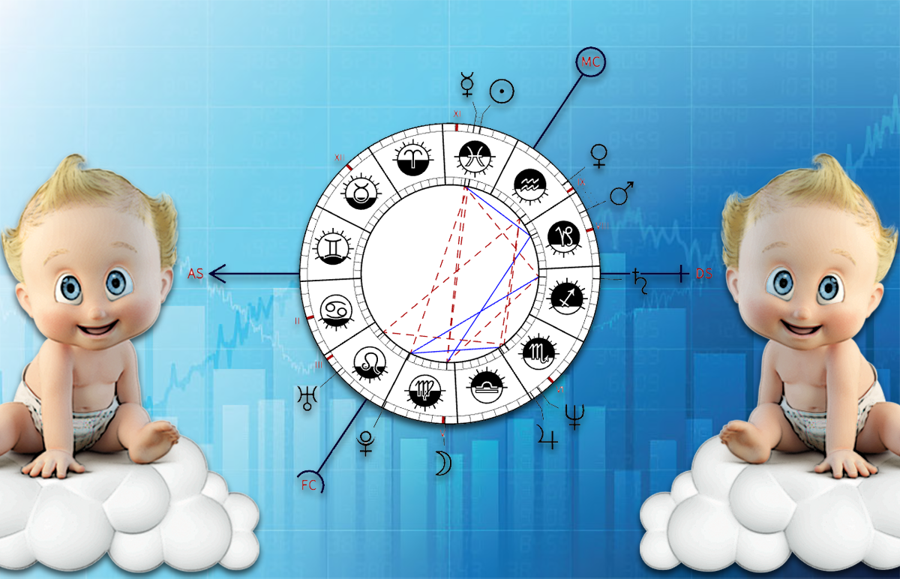
The diagnosis of an innate temperament, in principle immutable, can therefore be that of an acquired behavior, therefore likely to be changed by decisive awareness and personal training and/or in the context of psychotherapy. At the end of this change in behavior and if it is complete and successful, a false reserved introvert can transform into a real non-shy extrovert and a real shy introvert into an apparent moderate extrovert. One can easily imagine the disappointment of a recruiter who would have selected the candidate for a position on the basis of his answers to a test, and would realize belatedly that he did not in fact have the desired personality profile.
Add to this that one can be introverted in public and extroverted in private and vice versa, and that the frequency and proportion of these behaviors varies according to the situations with which the individual is confronted and his possible shyness. As a result, no serious psychologist would dwell on carrying out tests and/or a statistical study relating exclusively to the criteria of extraversion and introversion: he knows from experience that these do not give significant results. in themselves and that innate temperament should not be confused with learned behaviors, even if the two are mixed. Extraversion and introversion are only meaningful factors if they have been assigned extremely specific meanings and combined with other personality assessment criteria that contextualize them.
“Extraversion” is a concept commonly used in a very large number of psychometric tests intended for the evaluation of the components of the personality. It has very significantly different meanings depending on these tests and their authors. To take just two examples, it does not have exactly the same meaning in the MBTI model (Myers-Briggs Type Indicator) derived from Jungian typology theory (therefore from old European culture) and in the standard model of Big Five which is not based on any theory a priori and is based on the purest American empiricism.
Finally, we cannot reduce a priori traits associated with Saturn only introversion, especially in ambiverted Saturnians, as it should be and even though ambiverts are little studied. A Saturnian dynamically open to signals from the outside world will behave as an extrovert. Certainly, he will be less and differently (in a more distant way) than, for example, a Jupiterian, but he will be too. Moreover, a large number of descriptive traits of the saturnian temperament can be found identically but dispersed in many items of the lexicography of each of the 5 dimensions of the personality of the model of the Big Five. This poses another kind of problem: in what way and within what limits are standard psychological tests (and which ones) are compatible with the study of astrological facts? When we make comparisons, we must not mistake the standard.
It is far from proven and obvious, from this point of view, that both extroversion and introversion are factors determined solely by astrological effects. It is necessary here to distinguish the part of the temperament which relates to the genetic heritage and that which belongs to the astrological effects which are grafted on it at birth. The observation shows that it is very possible that basic factors such as extraversion and introversion are partially innate and relative phenomena resulting from the genetic matrix, and that the zodiaco-planetary factors which imprint themselves in the system nervous at the natal moment manifest their effects there only within the pre-established framework of this matrix. This would mean that the tendencies expressed by a Natal chart can be experienced indifferently on the level of extraversion or introversion. These tendencies would remain the same, but they would be more exteriorized in extroverts and more interiorized in introverts.
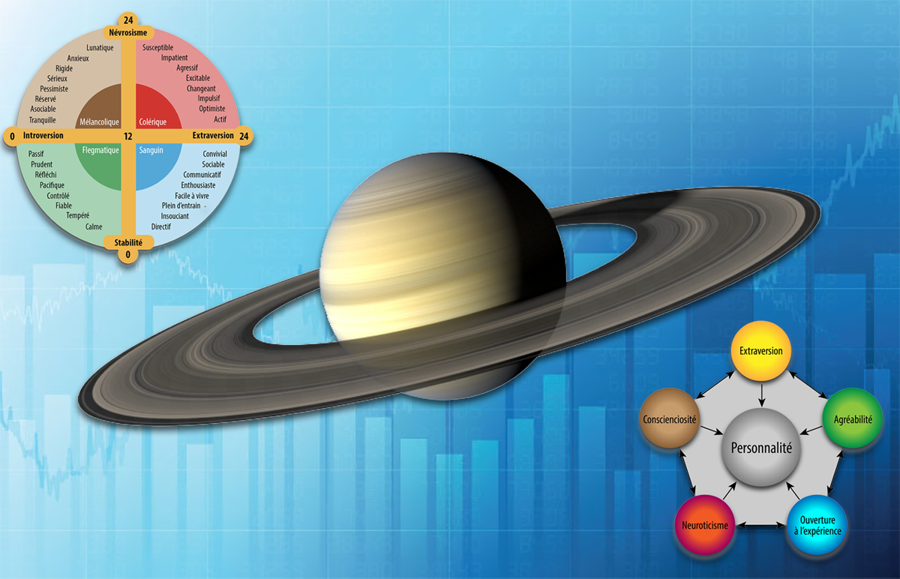
The correlation of the saturnian temperament with the extraversion score obtained with the result of who knows what statistical test carried out according to a scale of 13 simplistic factors intended to measure extraversion on 113 astral twins, which actually form 36 separate groups born at different times, therefore has no meaning. Indeed, the samples tested are tiny (3,138 individuals on average per group), extraversion as assessed by the tests is not a relevant standard, and it is not even proven that the test was carried out in conditions guaranteeing the objectivity of its results. And finally we demonstrated that it was false to affirm that this test had been carried out during “the strongest Saturn event during the entire period from 3rd to 9th March”.
All the data on which this statistical study is based are false, biased or impertinent with the exception of the optimal accuracy of the natal times. And the latter only had the effect of making it possible to demonstrate that these 113 twins did not form a homogeneous group, contrary to Dean’s assertion. Geoffrey Dean therefore demonstrated nothing in this pseudo-experiment intended to establish a correlation between Saturn and the extroverted temperament. He only (made) a mistake and threw anti-astrologer dust in the eyes of his readers.
He made another major mistake by regarding the hypothetical saturnian temperament as a “type” absolute disconnected from the whole to which it belongs. This set is made up not only of all the planetary configurations of the period concerned (astrological variables), but also behavioral variables (eg shyness) and all the extra-astrological variables whose beam also determines the personality of the subjects. tested. However, all these variables had a decisive influence on the answers to the questions posed by the personality test. A temperament does not exist in a vacuum. It is part of the particular context and a conditional history that necessarily modify and at least the breadth and intensity with which it is expressed. The true personality of an individual is the psychological fact that emerges at the moving crossroads of this network of conditionings and determinisms, and not an absolute and independent element fixed in a theory or a more or less empirical model claiming to describe it.
In short, Geoffrey Dean made the same mistake as the astrologers “traditional” fatalists, for whom the personality of an individual is entirely determined by his birth sky. It should be remembered here that Dean was one of them for a long time, and that he does not seem to have learned the slightest useful lesson from it: he is content to castigate what he believed in and what he stupidly practiced, that is to say the worst form of astrology there is, which is unfortunately the most widespread.
What Dean should have studied and tested is how the saturnian temperament is expressed in astral twins given the extra-astrological variables. This sample of 113 individuals was in fact composed of males and females, rich or poor, well or unloved, well or badly brought up, tall or short, sick or healthy, intelligent or stupid, educated or ignorant, elder or younger, sane or psychiatrically ill, beautiful or ugly, nice or bad, strong or weak, moral or immoral, socially adapted or maladjusted, believers or atheists, shy or assertive, traumatized or not, creative or not, etc. And all of these variables have a direct and powerful impact on character building.
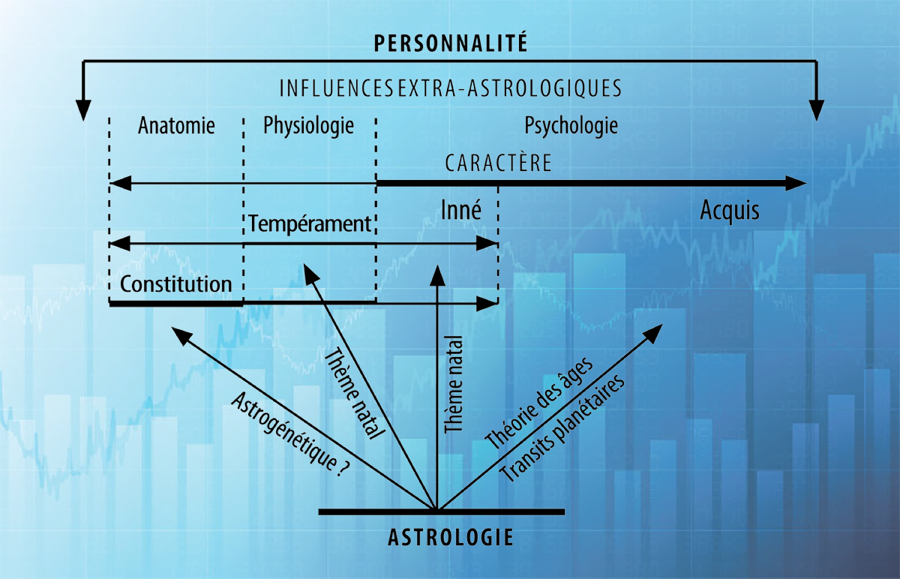
The least methodological precaution should therefore have been to form groups characterized by the same variables and test them separately. He could thus have confirmed or invalidated that the saturnian condition is experienced differently depending on the constellation of extra-astrological variables within which it is expressed. His study would then have been consistent with its object, assuming that the responses of these individuals to the personality test he used had an optimal degree of objectivity, which is unlikely but impossible to demonstrate. In order to avoid as much as possible the possible confusion between temperament and behavior, he should have even, for example, tested the answers to the tests of a group of shy individuals before and after they had succeeded in overcoming their shyness, and compared these answers. to those of another group made up of people who have remained shy. He should then have replicated these various studies based on other personality tests that would not only measure the degree of extroversion, but all the factors selected by these tests as major personality characteristics. He would thus have carried out a truly scientific study.
That’s not all. The same natal sky or the same personality can be experienced on different planes such as those of the mood, of the stock, of the thought, of the passion and/or the creation. The mood plan is the most common: we are content to be what we are, to live our temperament and our behaviors in our work, our free time and our life as a couple, family or single. The action plan is less common: we have strong commitments to modify our concrete environment. In this case, temperament and behavior manifest themselves in the exterior, whereas they are more internalized if the tendencies of the personality are oriented and specialize on the plane of thought. As for passionate and creative commitments, they can concern exteriority as well as interiority according to their objects. The same personality, the same temperament or the same natal sky will therefore be expressed in a very different way according to these different orientations. And these will influence the self-perception and self-evaluation of the individual, and therefore their answers, true or false, biased or not, to simple or complex personality tests and relevant or not.
We thus arrive at a personality meta-analysis which transcends and overflows on all sides the Subject tested and described by models. The temperamental and characterological tendencies of this Subject are only pure virtualities if they are not invested in a Object which actualizes them and therefore makes them exist while transforming them. The personality of the Subject and its evolution are therefore part of the Relationship that he establishes with the Investment Object of his tendencies. This Object may or may not be adequate, and from this adequacy or inadequacy results a Integration success or failure of all of these factors. And ultimately, the real and accomplished personality, saturnian or not, will be the balanced or unbalanced resultant of these processes.
It is only within the framework of this kind of multifactorial analysis integrating multiple internal and external variables to the Subject that one can hope to be able to grasp the astrological reality in all its stochastic and conditional complexity. And not by filling out simplistic and biased personality questionnaires from which biased statistics are drawn, as if the study of the psychological functioning of human beings were reduced to filling in crossword or sudoku grids to extract lexicographic laws or digital. So do not let yourself be impressed by this kind of anti-astrologer tests.
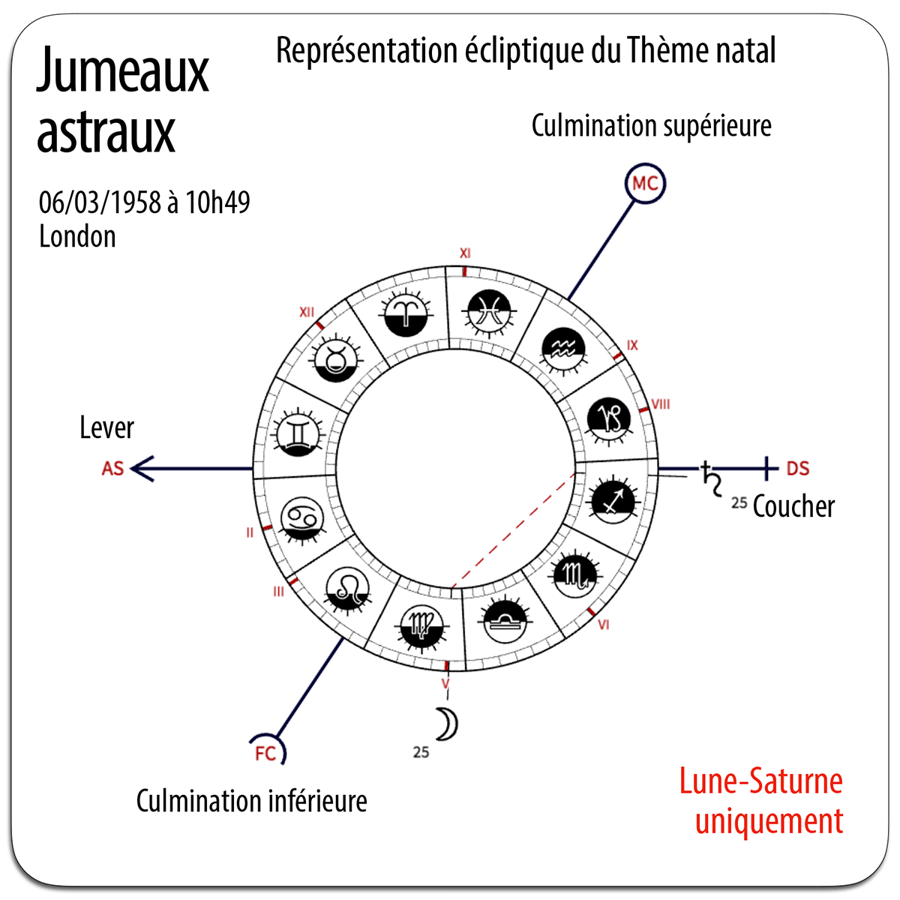
After this essential critical review of psychologist theories and the questionnaires that derive from it, let us now return to the deception of statistical merchandise during the study that Dean carried out on 6th March 1958. Quackery and pseudo-psychological bullshit apparently were not enough for him not, Geoffrey Dean also engaged in a deception on the goods, which is a scam at all.
He claims to have produced a statistic on the correlations between Saturn’s setting and the psychological and cognitive characteristics of astral twins. In reality, what has been tested is not the supposed influence of a single planet, Saturn, but of two: the Moon-Saturn couple associated by a square Aspect. But nowhere does he mention this fact or specify what would be the lunar characteristics, which are very different from the saturnian ones, and how the association of the lunar effects and the saturnian effects produces one or more types of behavior irreducible to the saturnian effects alone. He seems to have viewed the Moon as merely an astronomical (not astrological) foil to Saturn, as modern personality theories do for introversion versus extroversion.
In order not to deceive those whom he claims to inform about his anti-astrologer merchandise, he should have carried out a test relating to the angularities of a Saturn without Aspect, which is not frequent but which exists. The only alternative would have been to stipulate in his initial hypothesis that he would take no account of the lunar effects although these existed because of the Moon-Saturn square, which would have been another form of fraud, intellectual this one. To sum up, Geoffrey Dean did not do a study intended to measure the supposed effects of Saturn. He objectively carried out a test measuring the associated effects of Moon-Saturn and, these being invalidated according to a method we have seen very questionable, he concluded that there was no saturnian effect. It is as if he had claimed to be testing the effects of an exclusively carnivorous diet in a population made up of both carnivores and vegetarians, when in reality he was testing the effects of an omnivorous diet without saying so, and that he had concluded that an exclusively carnivorous diet had no effect on either. This is not only a scam, but also pure delirium.
We have demonstrated that a temperament, whether of astrological cause or not, is a factor that can only be understood and studied — and possibly isolated for the needs of the statistical cause — by associating it with other factors, behaviors, themselves induced by a multitude of variables. And this while being without illusions about the relevance of the descriptive theories of personality and the objectivity attributed to the answers given to the questionnaires, especially when these theories and questionnaires are considered as impartial reference standards. The result of this demonstration is clear: Geoffrey Dean’s study is psychologically and statistically insignificant. It is so not only because it does not meet any of the indisputable criteria that have just been listed and analyzed, but also because of deception on the goods.
We could therefore remain on this conclusion without appeal. But to be completely complete, it is however essential to now engage in a thought experiment. What would have happened, what could have been observed, what could have been the results of this study if Dean had really tested the object which he himself defined as being, not Saturn in itself, but a square Aspect between Saturn and the Moon?
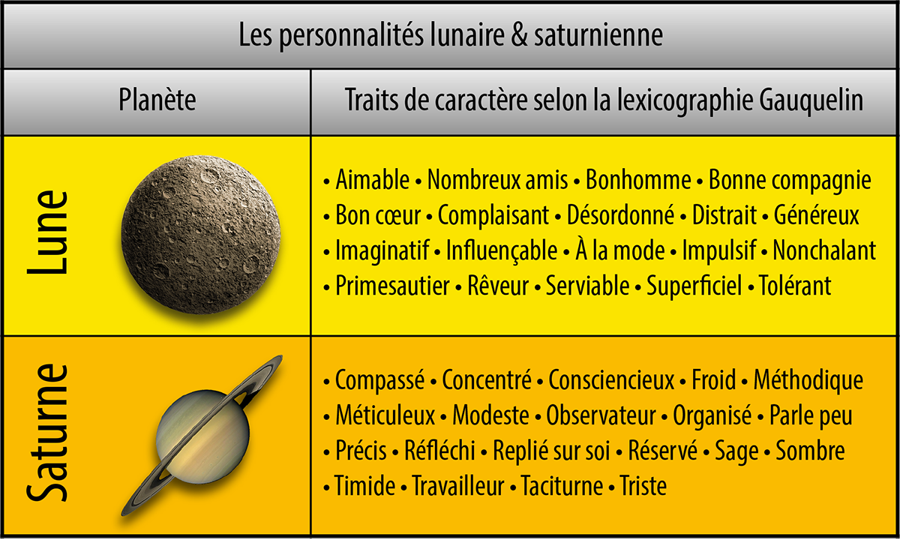
To test this hypothesis, we must evoke a phenomenon that we have not yet addressed: that of the simultaneity or alternation, concordant or discordant, of the different poles or facets of a personality. No one experiences all their tendencies at the same time, and the cohabitation between some of them can be harmonious or conflicting. Each situation, each context with which an individual is confronted is likely to make him favor one tendency or another, and therefore to make him appear in a different light for an outside observer. Some tendencies may seek to control, subjugate or even eliminate others, which may induce repressions that are more or less well experienced. In the most extreme cases, this can result at certain periods of life in what may appear to be a sudden change in personality when this is not the case: it is a revenge of the repressed, of a reorganization of the psychological space, voluntary or not: the fundamental components of the personality remain the same, but they are now hierarchized differently. The different poles or facets of a personality are therefore part of a simultaneity and/or a chronology.
▶ To illustrate this phenomenon, consider the example of an individual who obtained very high scores in extraversion and very low in agreeableness in his answers to a questionnaire Big Five. He is therefore considered to be sociable, active, eloquent and expansive but at the same time equally likely to be critical, cold, unsympathetic, stern and suspicious. If these two poles are of equal power and dissociated, he will not be able to do otherwise than express them alternately by showing himself alternately open or disagreeable, available or quarrelsome, etc. If his sociable-eloquent tendency effectively controls his disagreeable-refractory tendency, he will be able to curb the effects of the latter. But if this control is ineffective, he will not be able to prevent himself from letting his unpleasantness express itself openly. If his sociable-extrovert tendency subjugates or represses his disagreeable-quarrelsome tendency, the latter will never appear in his outward behavior, but he will then be perceived as a falsely relaxed being with suspicious ulterior motives, etc. Finally, if during a pivotal period in his life his behavior changes completely, the sociable-extrovert will turn into an unsympathetic critic with all the more virulence for having masked and repressed this facet of himself for a long time. even making an assault of deceptively enthusiastic hypocrisy. The same configuration composed of the same elements can thus produce different types of personality in simultaneity and chronology.
▶ For astrology, a square between two planets is considered a Aspect “dissonant”: it induces conflict, antagonism or discontinuity between two psychological poles. The psychological tendencies expressed by the planets linked by this dissonant aspect clash, each seeking to take precedence over the other. Problems with the dynamics of this dissonance can lead to multiple individual responses or behavior patterns. The most frequent responses range from the flexible or rigid subordination of one tendency to another, to the partial or total repression of one tendency by another, passing through an alternative experience of the two poles. Badly integrated, badly managed or badly experienced dissonances can induce deep tensions and painful contradictions within the psychological universe. However, the experience and practice of astrology show that beings who manage to dynamically manage their conflicts and contradictions — and therefore their dissonances, squares or oppositions — become more vigilant, more masters of themselves, more solid than others.
Independently of the effects of any extra-astrological variable, there are therefore different theoretical answers, adapted or not, to the problem posed by a square. It is therefore not possible, in the thought experiment in which we are engaged, to test only one of them. Furthermore, it is impossible to know a priori how the 97 false and the 12 identical astral twins of Dean’s sample of 6th March 1958 each reacted to this problem, the probability of one reaction rather than another being determined by all the non-astrological variables. The table below gives an overview of the 14 main possibilities of theoretical responses to the same Saturn-Moon square. Each of them constitutes a different organization of the facets of the same personality, and therefore a distinct behavior, irreducible to the 13 others.
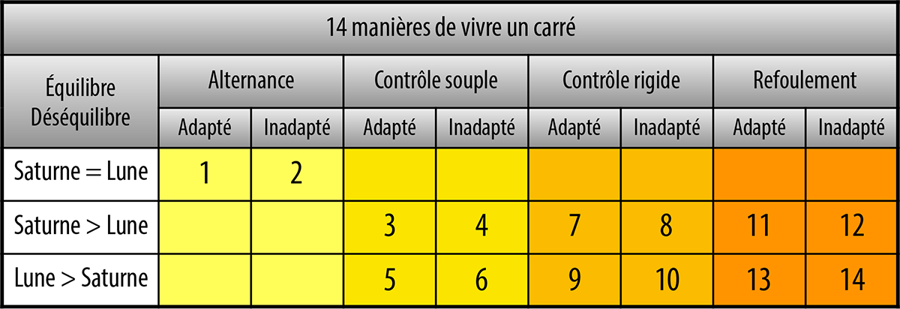
Each of the 12 other dissonant Aspects (dissonant conjunction, square, opposition) of this Astral Chart must be the subject of the same treatment, this figure being a function of the extent of the orbs that have been retained here, extent itself determined by the theory of the Aspects developed by the researches of contemporary astrology. The whole produces a range of (14 × 12 =) 168 theoretical possibilities generating as many different experiences of this same Chart, a quantity which greatly exceeds the number (113) of true-false astral twins concerned by Geoffrey Dean’s study and even more that (12) of individuals born around 10:49. And yet these factors concern only the dissonant Aspects. If we add the 4 Consonant Aspects and the effects of the zodiacal Signs, if we consider that this Chart can be experienced in extraversion, introversion or ambiversion, and that we introduce the influence of all the extra-astrological variables, this quantity of possible qualities is even greater.
That’s not all. This planetary set is hierarchical, and the order of importance of its elements is first determined by the criterion of angularity, that is to say the presence of the planets at their rising, setting and upper and lower culmination. It is moreover on this criterion that Geoffrey Dean based himself to make 10:49 the fetish moment of his study, Saturn being then exactly in the process of setting. And to achieve his statistic on extraversion, he remembered that he gathered all the couples of twins born 3 hours before and after 10:49, which makes them false twins since inside this time range several planetary hierarchies are possible. But neither the Aspects nor the planetary angularities need to be exact to be effective. This is what the Gauquelin statistics show. Given this fact, taking into account only a time range of ±1 h 30 around 10:49, divided into 3 slices of 30 minutes, we obtain every 1/2 hour different angularities. This phenomenon is shown in the following table.
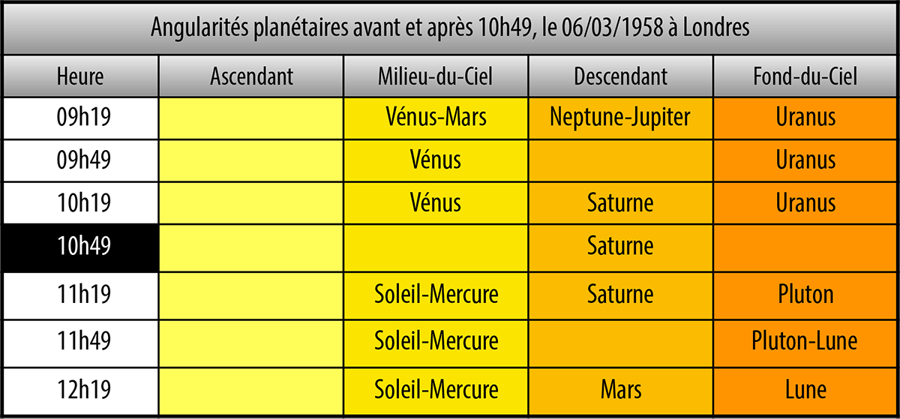
This table arbitrarily divides Geoffrey Dean’s 113 astral fraternal twins into 7 groups of real ones, the latter having actually been born under a similar sky. These groups, it should be remembered, can only be made up of about 2 to 6 individuals according to statistical probabilities. Each of these 7 groups of 2 to 6 people should therefore have been evaluated according to their own characteristics of planetary angularities and the different possible behaviors associated with them and which we have mentioned, and taking into account the multiple extra-astrological variables which have also determined these behaviors. It follows that if the 6 twins born in the immediate vicinity of 10:49, or all the others born from 1/2 hour to 1 hour before or after, had exactly the same experience of the same Chart which would have produced exactly the same personality, it would only be an insignificant statistical coincidence, and not a fatalistic astrological law.
To be convinced of this, just zoom in on the 6 indisputable pairs of astral twins from 10:49. It is not known whether they are at the same time astral and uterine twins. If they are uterine, we do not know if they are monozygotic or monozygotic, and in what proportion. We also don’t know if they are 3 pairs of twins or 2 triplets. We do not know which were born into a rich or poor family, and we do not know if they were wanted or not. It is not known whether some have inherited genetic defects that significantly alter the expression of their personality. We do not know if they were well or badly brought up or educated, and in what type of socioculture, etc. In short, we know nothing, strictly nothing about their terrestrial determinisms which nevertheless contributed to the production of their “character traits” and the progressive edification of their character.

This quantity and complexity of possibilities does not mean that any statistics on astrological effects are unachievable. A psychologist based on the Big Five is entitled to isolate a sample composed, for example, of unpleasant and unscrupulous extroverts to compare it with another consisting of pleasant and very conscientious extroverts in order to obtain results that may or may not be useful for any validation research. We can also isolate the Saturn-Moon square to make statistics on the 14 possibilities that the individual has to react to this celestial incentive by contextualizing these reactions, that is to say by associating them with a selection of variables. clearly defined. And it should be done by strictly respecting this protocol and these methodological precautions, and not indulging like Geoffrey Dean in pseudo-scientific anti-astrologer quackery. This is obviously a little more complicated to do than a stupid, simplistic and biased study on extroversion.
It remains to mention the case of uterine twins, who are both biological and astral if they are born a few minutes apart. All the factors and the variables associated with them apply identically for this type of twin birth. But there is of course a very big difference between astral twins and bio-astral twins, since they are conceived by the same mother and their relationship develops within the same family and socio-cultural circle.
Twins are usually born on the same day (except in the case of births around midnight of course) with an interval ranging from 4 minutes to 24 hours, the average being estimated at 17 minutes. And 17 minutes may be enough of a gap for them to be born under a very noticeably different sky. In terms of statistics, monozygotes (“identical twins” from a single egg) represent 1/3 of twin births against 2/3 for dizygotes. About 4/1000 monozygotes and 8/1000 dizygotes are born in the population of more or less white color (but 16/1000 in blacks and 4/1000 in Asians considered as “Yolks”). Monozygotes are of the same sex (50% male and 50% female). Dizygotes are 50% same sex and 50% different sex. Note in passing that contrary to what we have long believed, monozygotic twins have real genetic differences. They number about 360 according to a recent count and are produced by mutations appearing in fetuses.
Until the end of the 1970s and the appearance of PMA (assisted medical procreation), astrologers or astrologers were rarely confronted with cases of uterine twins, unless they themselves had been or that they had any among their relatives. This probably partly explains why most of those who refer to astro-fatalism “traditional” believe that uterine astro-twins necessarily resemble each other because they were born under the same sky. And that they generally put on the account of the often insignificant gap between their times of birth the difference that they are well obliged to observe between their respective temperaments or behaviors.
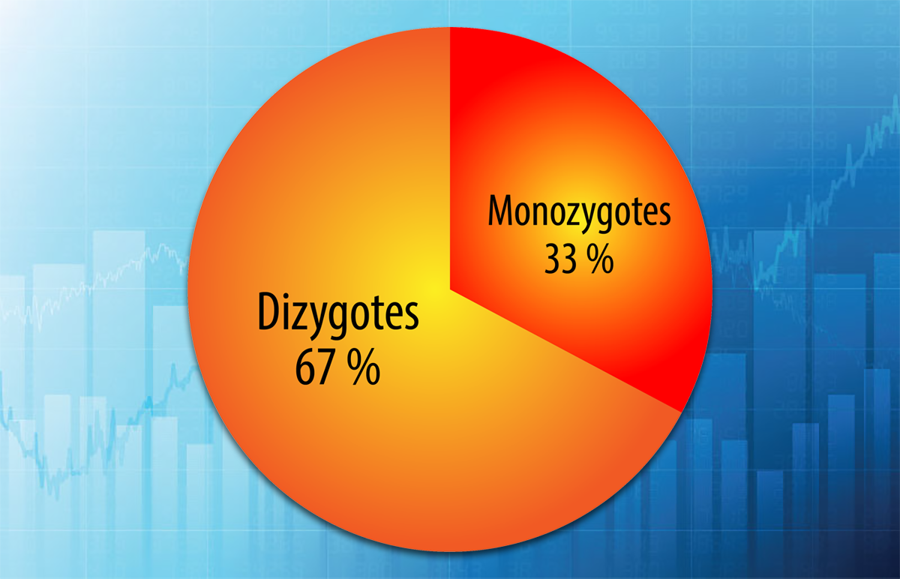
These astrologers or astrologers, who are unfortunately in the majority, will however have to get more and more used to the twin-boom caused by the PMA. This technique has indeed boosted the number of births of twins. A couple using assisted reproduction has a 25% chance of having a couple of twins (against 1.6% naturally), and 2.5% of having triplets (against 0.03% naturally), and the number quadruplets, quintuplets and sextuplets is also increasing. And with or without PMA, the age of the mother, constantly increasing in developed countries, also plays its role in this modern gemello-boom, since the probability of a natural multiple pregnancy is 5.8‰ at 20 years of age compared to 13‰ between 35–39 years of age, i.e. a risk multiplied by 2.2.
In short, astrologers or astrologers will have to question their certainties. And admit, faced with all these more and more frequent accomplished twin facts, that the horoscope is not the Subject, but a cartography of the main stars of the solar system at the time of its birth, whether it be twin or not. And that the twins are not summoned by some obscure fatality to react identically to the celestial promptings which they have in common. In this sense, Geoffrey Dean is right (it happens to him like everyone else) to write that the problem of twins is a “nightmare” for astrologers. But that is only one for those of them who believe in astral hyper-determinism.
For the others, the astro-conditionalists, twinning is only a reality a little more complex than that of a single birth. And since the horoscope is not the Subject, the same Astral Chart can be experienced by one, two or more, each individual by preferentially embodying/integrating a pole or a characteristic configuration in a dialectical relationship with the other(s). Or to take an image, the Natal chart can be considered as the same musical score played in solo, in duo, in trio or in quartet, each interpreter having his privileged instrument.
Thousands of uterine twins have been subjected to personality tests such as the Big Five. They showed that the monozygotes resembled each other very moderately in temperament and the dizygotes very little or not at all. There is therefore no systematic correlation between genetic inheritance (identical in monozygotes), physical resemblance and temperamental similarity. We do not know if the time differences have also been systematically tested in order to check their possible impact on the results, which is a pity but it does not really matter. It should be noted that astro-uterine twins are determined by a very different extra-astrological variable absent in astral twins in general: it is about coexistence in the same social and family environment. The roles of breeding and parental education will therefore be important factors favoring or not the affirmation of individual differentiations.
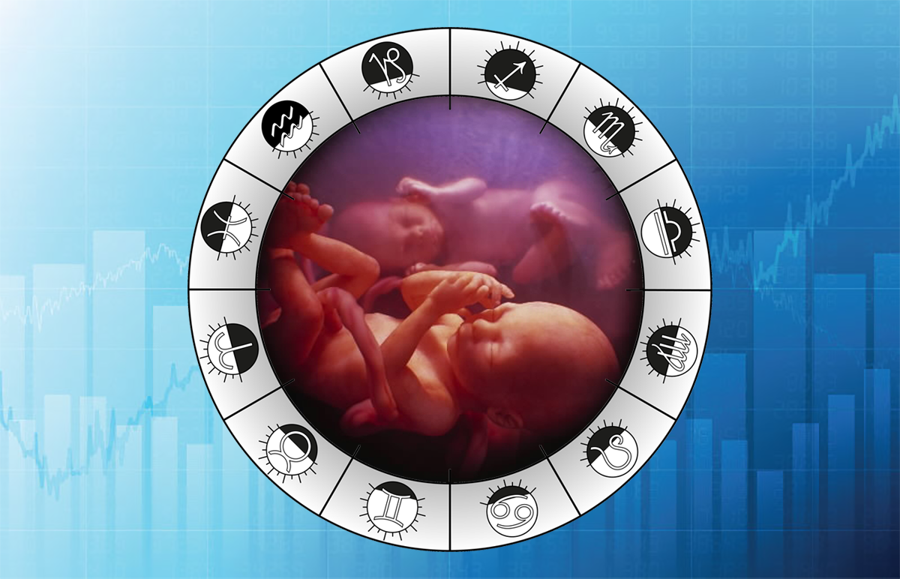
Whatever the astrological factors involved, twinship is embodied through three main types of relationship that are specific to it. These are the fusional relationship, the duo-duel relationship (couple effect) and/or the dominant-dominated relationship, which can combine in varying proportions and change over time. The importance of the time difference combined with the conditions of breeding and education are the determining selectors of these combinations and proportions.
▶ The fusional relationship: it is obviously very strong during the fetal period, continues for the first 2 years and generally slackens with the end of the first sidereal revolution of Mars… which is precisely about 2 years. In the succession of planetary ages, in fact, one of the major learnings of the marsian function is that of the duo-duel, that is to say of the concrete aspect of individual differentiation. But not all twins are equal when it comes to this loosening of the initial fusion. Monozygotes born with a minimal time difference would seek more to perpetuate the fusion in a relationship of dependence which is characterized by behaviors of unconscious mimicry. Around the age of 2, this dependence generally evolves towards interdependence, a source of autonomy, and in adolescence most end up developing real independence. Monozygotes born with a significant time difference would be less fusional and dizygotes even less.
It is necessary to differentiate the relationship of emotional symbiosis from that of psychological fusion. The first originates in a common fetal experience that leaves very deep traces in the post-uterine behavior of monozygotes, regardless of their time difference. The second would be a result of the time difference and therefore would be partly astrologically determined. Very small, this gap can encourage the twins to live identically their relationship to their native sky. They will then have very similar temperaments and behaviors, all the more so as the mimicry will be strong. But this inevitable initial mimicry can cause similar behaviors which in fact cover different temperaments which will gradually end up manifesting themselves. In this very common case, the twins will have “chosen” to dialectize their relationship with their identical sky, each embodying one or more poles. This is of course not a “choice” conscious, and therefore not of a real choice. Emotional symbiosis-fusion then coexists with psychological differentiation in ways that vary from person to person.
▶ The duo-duel relationship: the construction of the identity of each of the twins is based on obvious temperamental differences. These can be relative or absolute. If they are relative, the twins “choose” in their common natal sky the poles that most differentiate their temperaments, while retaining certain identical elements. If they are absolute, the twins construct their identity “mirrored”, by a relationship of inverted symmetry, one embodying opposite poles of those embodied by the other. They are therefore hyper-complementary: the weaknesses of one are the strengths of the other and vice versa. Each can thus rely on the other to do what he himself cannot do: they oppose each other in a duel but complement each other as a duo, and the duo is inseparable from the duel. From relative to absolute, all sorts of combinations are possible and none is predictable. These twin relationships in stochastic duo-duel are both hell for astro-fatalists and paradise for anti-astrologists. This other duo-duel between hell and paradise is their problem, and not that of the conditionalist astrologers for whom this type of twin relationship is part of what they observe regularly, knowing that for them the horoscope is not the Subject.
▶ Dominant-dominated relationship: it is an unbalanced variant of the duo-duel relationship. In the duo-dual interaction, there is no equality between the twins: they play a score where there may be rivalry, but it remains complicit and without seeking domination. In the dominant-dominated relationship, on the contrary, complicit rivalry can turn into open conflict, one seeking to establish his power over the other. One thus behaves as a leader, the other as a follower, these roles not always being definitive and which can be reversed depending on the situation. They are or become definitive if one of the twins has a much more assertive character than the other. If they have the same temperament, so they embody their native sky identically, the follower will tend to systematically imitate the leader while suffering from never being able to live up to him, which can induce envy and jealousy. If they have different temperaments, so they embody different or opposite poles of their native sky, the follower may have more contrasting behaviors. In certain cases, quite frequent, this apparent submission of the follower will only be a deceptive facade allowing him to discreetly develop his own personality in the shadow of that of his brother who needs more than him to occupy the leading roles. In other, rarer cases, the overwhelming and dominating personality of the leader does not allow the follower to develop his own, at the risk of serious dysfunctions. All sorts of combinations are possible and none is determined by astrological fate.
It is within these relational frameworks that astrological determinism operates, which demonstrates its relative character. There is therefore no reason for twins born with a very small time difference to have identical personalities and develop the same types of relationships between them.
▶ An example is given in a case study of Rémy and Pascal, monozygotic twins born 4 minutes apart: if they have a common temperamental background, they nevertheless show very different behaviors and their relationship is more like “duo-duel”. Their mother, an intelligent person and aware of the specificities of the twin condition, raised them by promoting the affirmation of their differences rather than insisting on their similarities. The map of the sky below is the one common to the two brothers. There is only one for two because the 4 minutes difference is in this case of negligible importance. The colored dots show how the twins distribute the planetary configurations. The pole Neptune-Venus-Mars (red dots) is that of their greatest resemblance; the poles Jupiter-Uranus-Sun-Mercury (yellow dots) and Moon-Saturn-Pluto (green dots) those by which they are very clearly differentiated.
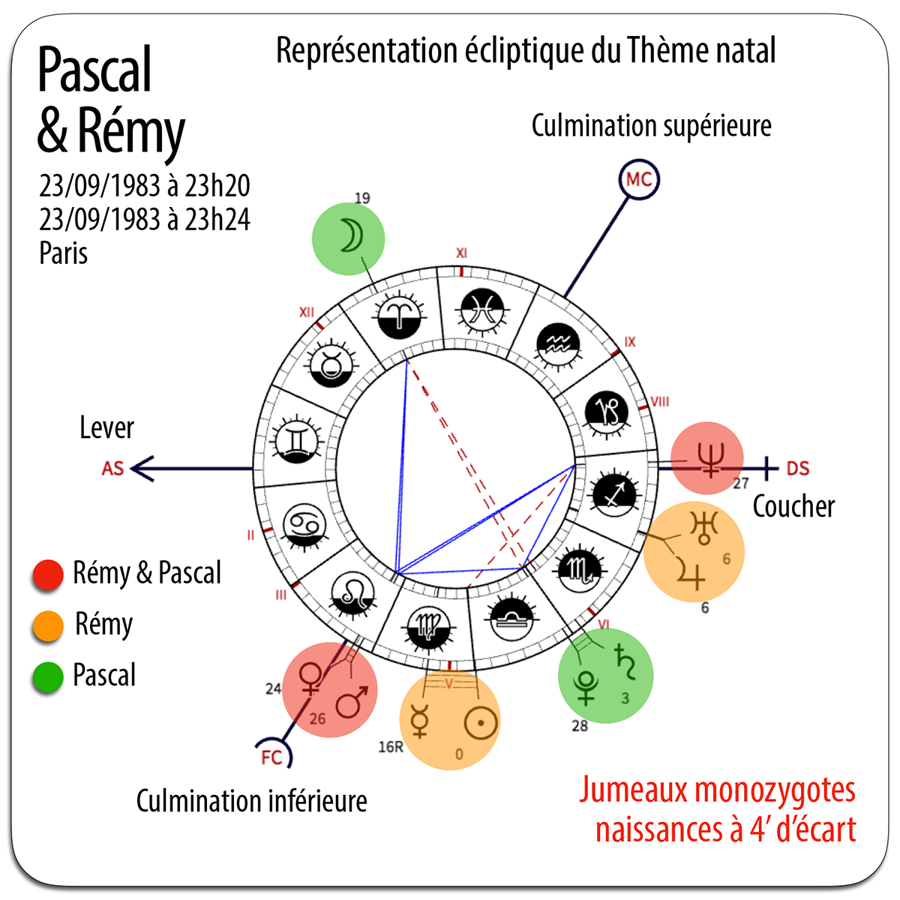
You can read the interpretation that can be made of this Common Chart in this article on The Charts of Two Monozygotic Twins. It was perfectly possible for an astrologer to foresee what these most probable differences would be if he knew in advance under which sky these twins were born. This is what happened, and the mother confirmed the relevance of the probable description of their respective personalities, made by the astrologer who had not, let us specify, met the two brothers before proceeding to this evaluation. forecast. This is a fact of experience quite common and inaccessible to fatalistic astrologers as much as to anti-astrological statisticians adept at simplistic and hyper-deterministic hypotheses.
Of course the distribution of roles and poles in the case of multiple twinning (3-4-5-6 individuals) is more complex. Monozygotic triplets are an extremely rare phenomenon, their probability being about 1/160,000. Whether monozygotic or dizygotic, these births generally occur with significant time differences: multiple twins are not all born under the same sky, and are therefore not astral twins. It follows that it is not by relying on the case of multiple uterine twins that anti-astrologists will manage to invalidate the reality of astrological effects.
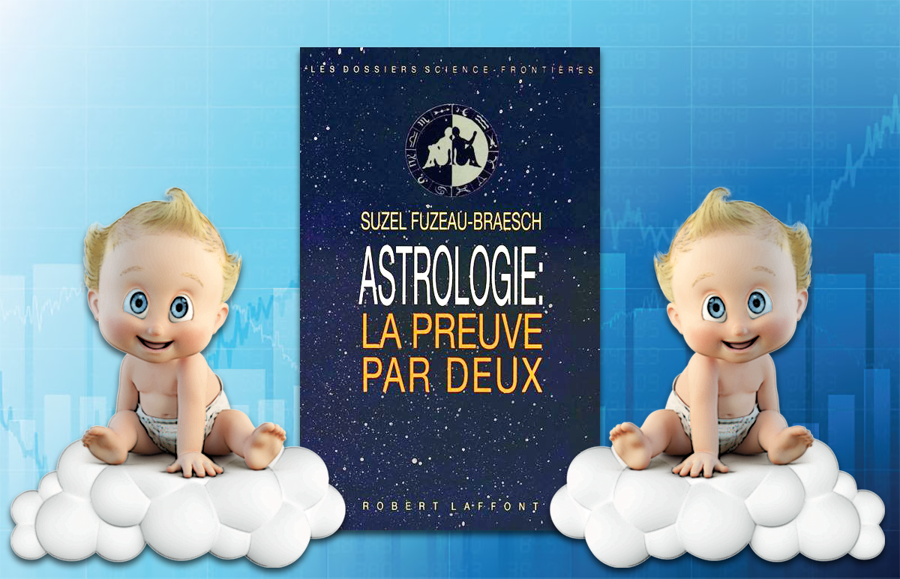
The multiple statistical studies on the correlations between uterine twins, their personalities and astrology have almost all been carried out by anti-astrologer scientists. The only exception to this rule is the experiment conducted by Suzel Fuzeau-Bræsch, director of research in biology at the CNRS and nevertheless pro-astrologist. The results of this study carried out on an initial population of 251 and effective of 238 pairs of twins were presented in the book Astrologie: la preuve par deux (Robert Laffont 1992). The positive results she believes she has achieved have led her to conclude that we “can now affirm that the time interval of twins can be at the origin of a part of their detectable psychological and behavioral differentiation on the respective basis of their two birth charts” and “makes it possible to clearly say that something other than chance presides over the polarization of the twin couple towards two psychologically distinct individuals and to conclude that the astrological factor does indeed exist”.
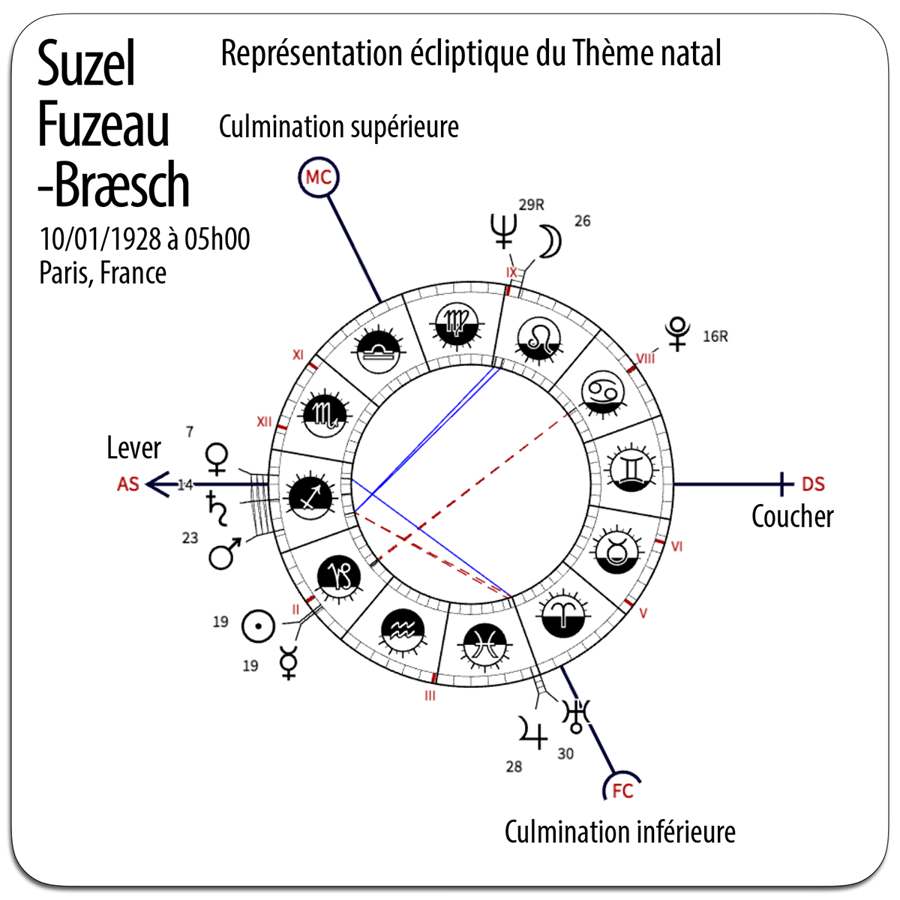
These seemingly positive results for astrology were of course greeted with excitement and relief by Symbolist astrologers “traditional”, who saw in it the confirmation of their hyper-deterministic conjectures and prognoses. The fact that these results were also obtained by a CNRS scientist also practicing a “exact science”, biology, has only naively heightened in their eyes their undoubtedly probative character. However, this statistical study is marred by multiple and often serious errors and astronomical, astrological and methodological inaccuracies which make its results not very credible.
The data, method and results of this study will not be presented here in detail. It is moreover an astrologer, in this case the writer of these lines, who made it the first critical review to demonstrate its manifest confirmatory biases, shortcomings and inadequacies in an article that appeared two years later, in 1994. It is indeed always better to start by sweeping in front of your open astrological door before denouncing the closing of that of scientism. The anti-astrologers of course then took over without knowing or wanting to know that an astrologer had preceded them. Among them, the one who made the most complete, objective, impeccable and implacable criticism of the study of Suzel Fuzeau-Bræsch is Frédéric Lequèvre, in an article published in March 2006 on the website of Observatoire zététique. Frédéric Lequèvre, teacher of technology and physics, is a resolute adversary of astrology. But unlike most pseudo-zetetic anti-astrologists, he has studied it enough to know pretty well what he is talking about, except when he firmly believes that Gauquelin’s statistics have been invalidated by the replications of the various anti-astrological committees. By reading therefore both the reviews of an astrologer and an opponent of astrology, you will be well informed about this statistic which proves nothing, if not the lack of methodological rigor and the lack of astronomical and astrological knowledge. by Suzel Fuzeau-Braesch.
We will limit ourselves here to taking the example of the sky maps of two monozygotic twins, Florence and Carole. It will suffice to illustrate practically all the errors and inaccuracies that make the results of this pro-astrologer statistic less credible.
▶ Data imprecision: birth on 10/11/1965 at 16:15 & 16:30. The geographical coordinates of the place are 43° 27′ N and 7° 14′ E. This latitude and this longitude are those of a place located in the middle of the Mediterranean Sea and in a place where there are no islands. The nearest locality is Antibes (43° 34′ N, 7° 07′ E). This is just one example of inaccuracy among many others.
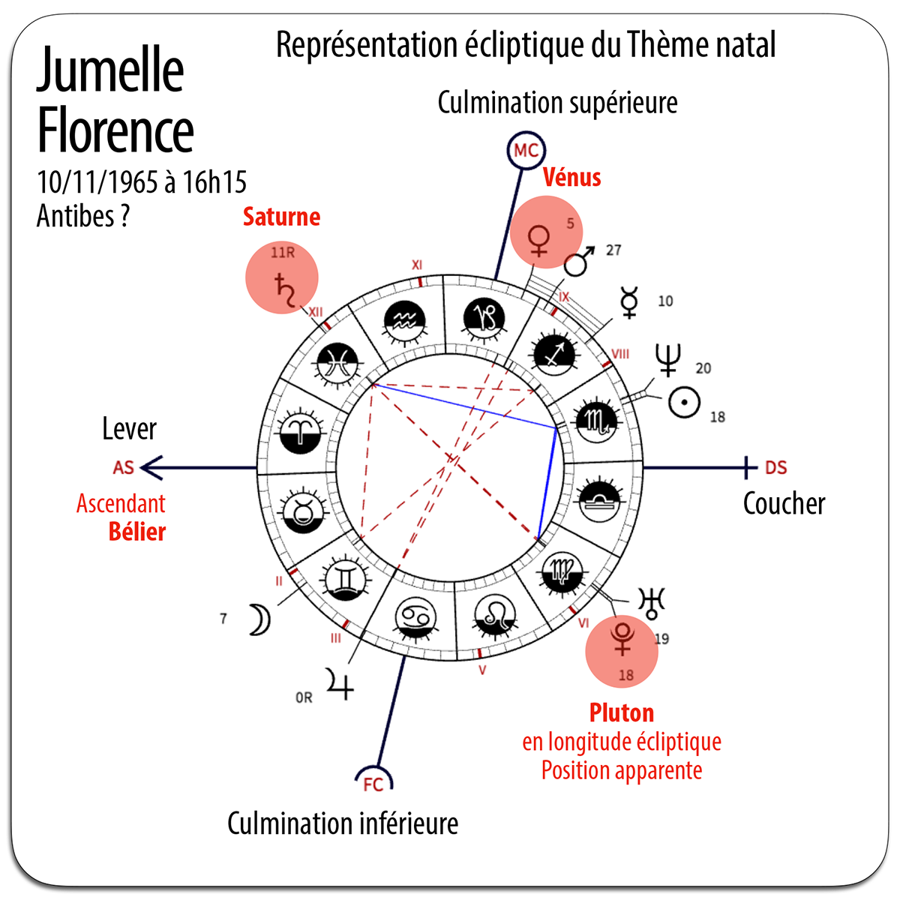

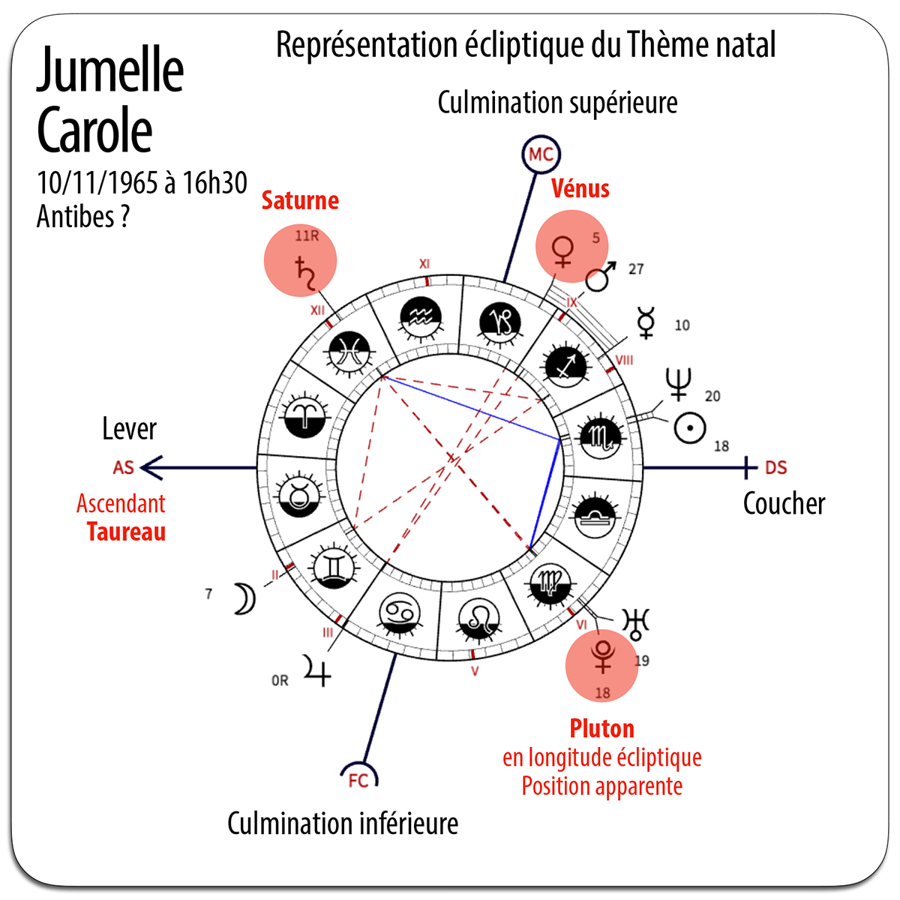

▶ Ecliptic longitudes & latitudes: Contrary to the Gauquelin statistics which she nevertheless claims, Fuzeau-Bræsch was based only on the projections of the planetary positions on the ecliptic plane, and therefore did not take into account their ecliptic latitudes. This major astronomical error prevented him from correctly assessing the precise and exact situation of the planets in the local sphere. If she hadn’t done it, she could have seen that the twins were born at Pluto’s sunset, in a “key sector” Gauqueline. This major error affects this statistic in very many cases, enough to make its results insignificant, at least as far as Pluto is concerned. But not only since other planets also have important ecliptic latitudes.
▶ Rising Signs: to explain the behavioral differences between the twins, Fuzeau-Bræsch relied exclusively on the fact that Carole had an Aries Ascendant and Florence a Taurus Ascendant, while the Gauquelin statistics invalidated the influence attributed to the Ascendant Sign. She did not mention the planetary angularities of the two twins, although she always does in the other cases. However, the same criteria must apply to all the elements of a statistic. Moreover, Fuzeau-Bræsch is talking nonsense when she writes about the identical Rising Signs for the two twins that “For example, two twins whose Ascendants are respectively 16° and 22° from the sign of Gemini will be, the first ‘more mobile, more expansive’ (= sign of Gemini) and the second ‘less expansive, more attached to the mother’ (= sign of Cancer).” This does not concern Carole and Florence, since they have Ascendants in two different Signs, but it should be noted. By making such assertions, Fuzeau-Bræsch shows that she understood nothing of the zodiac.
▶ Orbs of Angularity: Fuzeau-Bræsch admits an orb of angularity around the points AS-MC-DS-IC but does not specify which one. Since in other studies it evokes a 10° or 15° orb, one can think that it took into account one of these. Let’s say it has chosen an orb of 10° in ecliptic longitude. In this case, Venus can be considered as angular (orb of 8°) in the Chart of Florence, but not in that of Carole. Florence would therefore be “venusian”, but not Carole. This criterion should have been the first factor discriminating their respective temperaments, according to the rules that Fuzeau-Bræsch imposed on herself for this study, but she did not retain it. This kind of small arrangement recurring very frequently, it affects the validity of the results thus obtained in sufficient proportions to invalidate them.
▶ Gauquelin areas: these have nothing to do with orbs of angularity as Fuzeau-Bræsch defines them, i.e. counted in degrees of ecliptic longitude. The areas or “key sectors” Gauquelin are indeed approximately counted in degrees in the local sphere and take into account the ecliptic latitudes of the planets. Since Fuzeau-Bræsch explicitly refers to these zones to legitimize her study, she should have taken into account the planetary presences in these zones. In the case of Florence, Saturn and Venus clearly fall within these “key sectors”, whereas in the case of Carole they are at their limits, so can possibly be excluded. Let’s recap: the two twins should have been considered “plutonian”, but they were not. Florence should also have been classified as definitely “Saturn-Venusian”, but she was not. Pascale should have undergone an assessment to verify whether or not she was “Saturn-Venusian” according to Gauquelin criteria, but it was not done. Another example of the absolute lack of astronomical and methodological rigor that affects this statistic and makes its results very meaningless, even invalidating them as it is repeated so frequently.
▶ Distinction by orb of angularity: when Fuzeau-Bræsch does not take as sole pretext a difference in Rising Sign to justify the differences in temperament between twins, she does so on the basis of another arbitrary criterion. She claims that between two twins having the same angular planet, the one born with the narrower orb of angularity is more characteristic of the influence of this planet. In the case of the two twins and using the Gauquelin zones as a criterion, Florence would thus be “more saturno-venusian” and Carole “less saturno-venusian”. However, this kind of vague and unquantifiable criterion does not exist in the Gauquelin statistics, for which a planet is or is not in a “key sector” (whether the boundaries of these sectors are valid and real or not is another matter). This distinction by orb of angularity is one of the foundations of Fuzeau-Bræsch’s study, which applies them to all the Charts. It is contradicted both by Gauquelin statistics and by observation. It therefore has no scientific value and its systematic use also invalidates the results of this statistic.
▶ Personality quiz: This study is based on a bewilderingly simple personality questionnaire based on positive or negative responses to statements such as “more energetic” or “less energetic”. The answers are given by the families, without any filter or any intervention by a third party capable of evaluating the inevitable very numerous subjective biases of these answers. Fuzeau-Bræsch nevertheless considers these uncontrollable answers valid and therefore whose objectivity is very unlikely in most cases. This does not prevent Fuzeau-Bræsch from questioning the validity of other standard personality questionnaires much more sophisticated than hers, when they contradict the traditionalist astrological assertions that she defends. Another flagrant example of a total lack of seriousness and rigour.
The key words used by Fuzeau-Bræsch to define the planetary meanings in his questionnaire are summarized in the table below. Their absence concerning Venus is due to an oversight on his part which is also culpable negligence. Their reduced number as well as the vague notions to which they refer are only a concentrate of the most simplistic and caricatural astrological assertions that can be found in popular astrology manuals. In no case can they allow us to identify the subtlety and complexity of planetary temperaments.
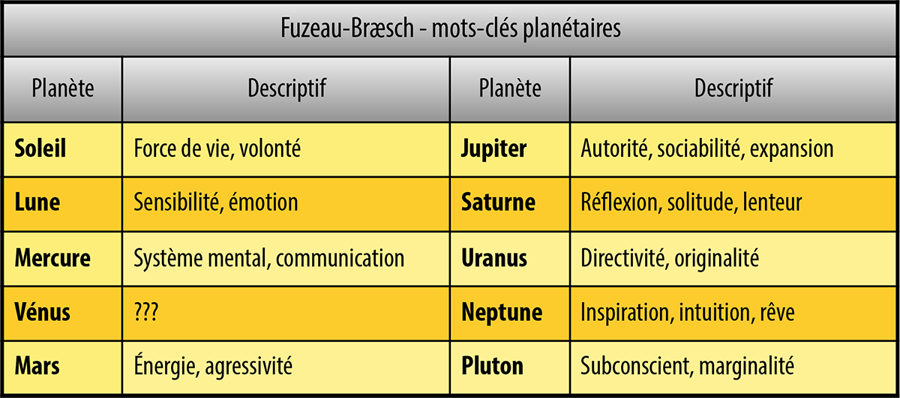
The key words used by Fuzeau-Bræsch to define the zodiacal meanings in his questionnaire are summarized in the table below. They have exactly the same characteristics as those relating to planetary meanings, except that the Signs are also defined by extroversion and introversion. Fuzeau-Bræsch claims that his study confirms the positive results obtained by other zodiac statistics. She mentions in particular a study conducted in 1978 by Mayo, White & Eysenck. The latter had concluded that the results of this statistic, relating to 2324 people having answered Eysenck’s EPI questionnaire, made it possible to affirm that astrology was able to predict, with a significant degree of probability, extraversion and introversion. according to the Sun Signs. A year later Eysenck retracted, having noticed during a replication that the observed effect disappeared if the individuals tested did not know the meanings attributed to their Sun sign.
These statistics based on the Sun Sign alone are insignificant, as we have already seen. That’s not the important thing. What is, on the other hand, is that Fuzeau-Bræsch mentions a replication of this same study conducted in 1988 by psychologist Jan J. F. van Rooij, which she sets great store by and according to which, I quote Fuzeau-Bræsch, “the astrological hypothesis is again demonstrated, odd signs have a much greater tendency than even numbers to be extroverted and this with good statistical significance.” But that is absolutely false. In fact, here are van Rooij’s conclusions: “The present study reproduces that of Mayo, White and Eysenck (1978; Journal of Social Psychology, 105, 229–236) confirming the astrological proposition that people born with the Sun present in a positive sign (Aries, Gemini, Leo, Libra, Sagittarius, Aquarius) are extroverted and those in a negative sign (Taurus, Cancer, Virgo, Scorpio, Capricorn, Pisces) are introverted. This result has been found, but only in subjects with astrological knowledge. As an explanation, a self-attribution process is suggested. Furthermore, this self-attribution effect has been shown to be enhanced when subjects are informed that the study is about astrology. Finally, it has been proven that subjects whose Sun was in a positive sign are particularly sensitive to such a signal. Although the validity of astrology itself could not be demonstrated, it is concluded that astrology can have a profound influence on people’s self-conception, due to psychological processes such as self-attribution and selective self-observation.”
Fuzeau-Bræsch therefore takes his wishes for realities, which is neither very rational nor very scientific. The questionnaire answered by the parents does not include any item concerning their familiarity or not with the psychological meanings of the Signs. If only because of this absence, the results of his statistics can therefore be highly suspected of very significant parental self-attribution biases. On the other hand, extroversion and extroversion cannot be expressed only by the Sun signs and even by the Signs other than the Sun. They concern both the planetary and the zodiac, according to complex, subtle and hierarchical modalities and combinations (the planets first, then the Signs) which can only escape such crude statistics. The table below shows the simplism of the zodiacal attributions according to Fuzeau-Bræsch. No need to go any further…
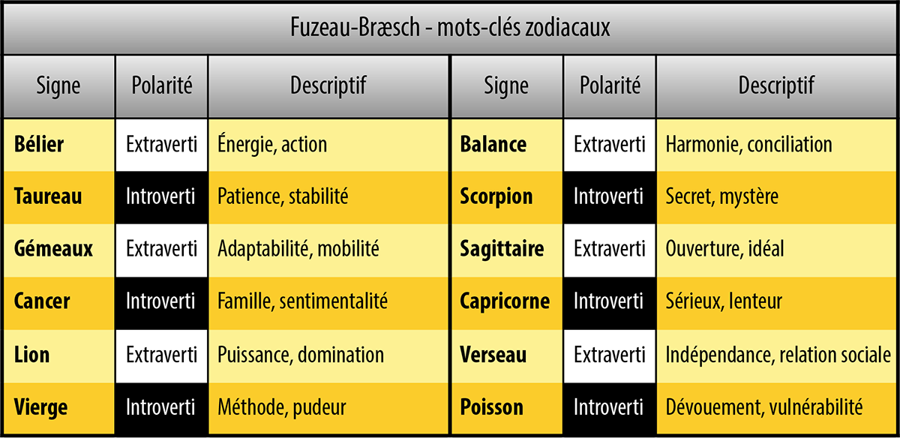
It should be noted that the keywords signifying the planets and the Signs are very significantly different from those used in the questionnaires communicated to the families. They are as follows: “Asset; affective; attached to mother; communicative; decided; directive; dominant; soft; emotional; energetic; expansive; farm; imaginative; independent; mobile; reagent; receptive; thoughtful; reserve; dreamer; secret; sensitive; serious; is required; social; supple (of character); steady; calm; lively”. A rigorous scientific approach should however have obliged Fuzeau-Bræsch to use the same keywords, in order to facilitate an objective external control of the raw data of this experiment. But it is true that throughout it the bias of the experimenter in the choice of the criteria used or not being obvious.
Finally, Fuzeau-Bræsch did not submit her study to the double-blind test, which she describes very well herself in her book: “Double-blind: methodological technique in biological, medical experimentation, etc., consisting in making the experimenter – and the experimented – ignore the nature of the samples – of the cases – used successively, these being composed of batches designated by a secret code. For example, the experimenter is ‘blind’ due to the fact that he only has information, when he operates, of a random code, which does not allow him to differentiate between his samples, real or control. He therefore does not risk being unconsciously influenced by any forecast of the results.” The study by Suzel Fuzeau-Bræsch is therefore a perfect example of all that should not be done in terms of statistics in general and astro-statistics in particular.
Fuzeau-Bræsch is, however, experienced in scientific methodological techniques due to her status as director of a CRNS laboratory and researcher in animal biology. One can therefore wonder why she showed such casualness and lack of objectivity in her astro-statistical study of twins. It is striking to observe that this kind of attitude is very common among professional scientists with a favorable bias towards astrology. This hyper-frequency, of which the case of Fuzeau-Bræsch is only one example among others, therefore needs to be analyzed and its causes elucidated if possible.
The first cause is epistemological and affects both theory and practice. From a theoretical point of view, modern scientific knowledge and astrological knowledge are very different. The field of investigation of the first is that of objectively measurable and quantifiable phenomena, while that of the second concerns stochastic effects whose measurement and quantification is by nature much more difficult to implement using conventional scientific methods. Moreover, modern science has cleaned up its field by regularly excluding all traces of its past that are incompatible with the advancement of its knowledge and paradigms.
This is not the case with astrology, which has taken too long to make its mark aggiornamento and therefore still remains encumbered by the strata of knowledge mixed with beliefs that it owes to its multi-millennial existence. A scientist with a favorable bias towards astrology is therefore forced, in one way or another, to sort through astrological knowledge in order to be able to isolate the elements which seem to him the most compatible with their own scientific knowledge. This is not easy and can encourage all kinds of mistakes. When reason is confronted with aporias in the face of a problem or a phenomenon that it must nevertheless try to solve or elucidate, it is intuition and the abductive approach that take over. And it is they who are at the origin of a very large number of major scientific discoveries… as well as all kinds of irrational illusions. We must make do.
From a practical point of view, through their training in the so-called sciences “accurate”, these same scientists are probably confused when they are confronted with the difficulty and the complexity of trying to measure phenomena of a stochastic nature such as astrological effects. This difficulty can encourage them to demonstrate a methodological tolerance that they would not allow themselves in the context of their professional activities. It is a thoughtful and cautious attitude of openness to the unknown that can be understood. But the purpose of scientific methodological techniques being to achieve maximum objectivity, any increase in the threshold of tolerance in their application then risks resulting in the various biases to which subjectivity and/or the effects of belief expose.

Finally, from a psychological point of view, we must not exclude the temptation among these scientists to relax the methodological discipline essential to their profession when they approach the field of what is considered by science as “paranormal”. The “burden of proof” rational, mathematical and experimental indeed exerts a constant and overwhelming pressure on all forms of scientific activity. For most scientists, this intellectual pressure is considered normal and those of them who find it too alienating free themselves from it by indulging in various hobbies or interests not directly related to science. They can deploy there without any rationalizing constraint their subjectivity, their freedom of spirit, their imagination, their imagination or their aesthetic sense. These occupations thus play a role of spiritual safety valve where they can give free rein to their fantasies and their irrationality. Most generally take care to maintain as perfect a seal as possible between the relaxation allowed by these hobbies and the tensions they owe to their professional activities. But the most gifted and fertile do not hesitate to free themselves from this tightness and to build original bridges between science, art, literature and poetry.
If it is astrology that they are interested in outside of their scientific activities and if they have a favorable bias towards it, the same provisions apply. But there is a difference, and it is significant. Contrary to art, literature or poetry perceived as harmless, even complementary to the scientific approach while ontologically not being able to replace it, astrology is considered by science as a pernicious and dangerous pseudo-science which must be denigrated and fought by all possible means. A scientist who expresses even the shadow of a positive opinion towards him is automatically ostracized by his scientific peers. Whatever its recognized scientific merits, it is then generally considered by them as a cross between a black sheep and a black sheep, traitor to the rationalist cause, and treated as such. At best, he is perceived as a being previously made all in one piece that the treacherous sirens of the paranormal have cut in two: a rational half, an irrational half.
Everything seems to happen as if most scientists who engage in pro-astrologer experiments have internalized this split. They therefore perceive astrology as a field where they consciously or unconsciously allow themselves to give free rein to their most subjective and irrational inclinations. The results of such positioning depend on the tightness between these two parts of themselves. If this tightness is absolute, they reserve for their scientific work the rigorous methodological approach based on a deductive and inductive thought aiming at objectivity. From then on, they perceive astrology as an art, a hobby foreign to science which allows them to give free rein to the fantasies of their imagination. If this tightness is relative, their initial training encourages them to try to integrate astrology within the framework of scientific knowledge; but to do this they believe that it may be legitimate to free oneself at least partially from the shackles imposed by this knowledge, and that abductive and intuitive thinking as well as a relaxation of methodological rigor may be required to achieve this end.
This is exactly what happened in the case of Suzel Fuzeau-Bræsch. Alongside her research in animal biology at the CNRS, she trained in astrology in its most symbolist, irrational and “traditional”, that is to say the furthest from official science. Its rational-scientific part prompted it to place itself in the wake of Gauquelin statistics, without however abandoning its beliefs in classical astrology. Such an attitude could only generate insoluble paradoxes and flagrant contradictions against a background of lack of methodological rigor and objectivity, all the more so as his astronomical knowledge is superficial, incomplete and often erroneous. This risky approach could only produce what it produced: pseudo-astrological and pseudo-scientific statistics. His studies on twins are the caricature example of what not to do, whether one has a favorable or unfavorable prejudice vis-à-vis astrology.
▶ The specific issues of astrological statistics
▶ Tests et prétextes : comment démonter l’astrologie ?
▶ Astrologie canine, astrologie cynique ? À propos d’une expérience statistique sur des chiens
▶ Carlson’s “experiment”: an example of anti-astrologist quackery
▶ The Petiot affair and the “Barnum effect” or the anti-astrologer circus
▶ Le problème des jumeaux en astrologie
▶ Uranus astronomique
▶ Sun-Uranus aspect
▶ Mars-Saturn aspect
▶ Astrologie et astrologies : écoles, courants et chapelles
▶ Results of conditionalist astrology
▶ Results of traditional astrology
▶ Results of statistical astrology
▶ The world according to Claudius Ptolemy, astronomer-astrologer and lighthouse of Alexandria
▶ Ptolemy and the error of the senestrogyrate Houses
▶ Introduction to the comparative results of astrologies
▶ Anar-show en hommage à Paul Feyerabend
▶ Ike Uncyfar and Astro-statistics on video

Les significations planétaires
par
620 pages. Illustrations en couleur.
La décision de ne traiter dans ce livre que des significations planétaires ne repose pas sur une sous-estimation du rôle des Signes du zodiaque et des Maisons. Le traditionnel trio Planètes-Zodiaque-Maisons est en effet l’expression d’une structure qui classe ces trois plans selon leur ordre de préséance et dans ce triptyque hiérarchisé, les Planètes occupent le premier rang.
La première partie de ce livre rassemble donc, sous une forme abondamment illustrée de schémas pédagogiques et tableaux explicatifs, une édition originale revue, augmentée et actualisée des textes consacrés aux significations planétaires telles qu’elles ont été définies par l’astrologie conditionaliste et une présentation détaillée des méthodes de hiérarchisation planétaire et d’interprétation accompagnées de nombreux exemples concrets illustrés par des Thèmes de célébrités.
La deuxième partie est consacrée, d’une part à une présentation critique des fondements traditionnels des significations planétaires, d’autre part à une présentation des rapports entre signaux et symboles, astrologie et psychologie. Enfin, la troisième partie présente brièvement les racines astrométriques des significations planétaires… et propose une voie de sortie de l’astrologie pour accéder à une plus vaste dimension noologique et spirituelle qui la prolonge et la contient.
Téléchargez-le dès maintenant dans notre boutique

Pluton planète naine : une erreur géante
par
117 pages. Illustrations en couleur.
Pluton ne fait plus partie des planètes majeures de notre système solaire : telle est la décision prise par une infime minorité d’astronomes lors de l’Assemblée Générale de l’Union Astronomique Internationale qui s’est tenue à Prague en août 2006. Elle est reléguée au rang de “planète naine”, au même titre que les nombreux astres découverts au-delà de son orbite.
Ce livre récapitule et analyse en détail le pourquoi et le comment de cette incroyable et irrationnelle décision contestée par de très nombreux astronomes de premier plan. Quelles sont les effets de cette “nanification” de Pluton sur son statut astrologique ? Faut-il remettre en question son influence et ses significations astro-psychologiques qui semblaient avérées depuis sa découverte en 1930 ? Les “plutoniens” ont-ils cessé d’exister depuis cette décision charlatanesque ? Ce livre pose également le problème des astres transplutoniens nouvellement découverts. Quel statut astrologique et quelles influences et significations précises leur accorder ?
Enfin, cet ouvrage propose une vision unitaire du système solaire qui démontre, chiffes et arguments rationnels à l’appui, que Pluton en est toujours un élément essentiel, ce qui est loin d’être le cas pour les autres astres au-delà de son orbite. Après avoir lu ce livre, vous saurez quoi répondre à ceux qui pensent avoir trouvé, avec l’exclusion de Pluton du cortège planétaire traditionnel, un nouvel argument contre l’astrologie !
Téléchargez-le dès maintenant dans notre boutique